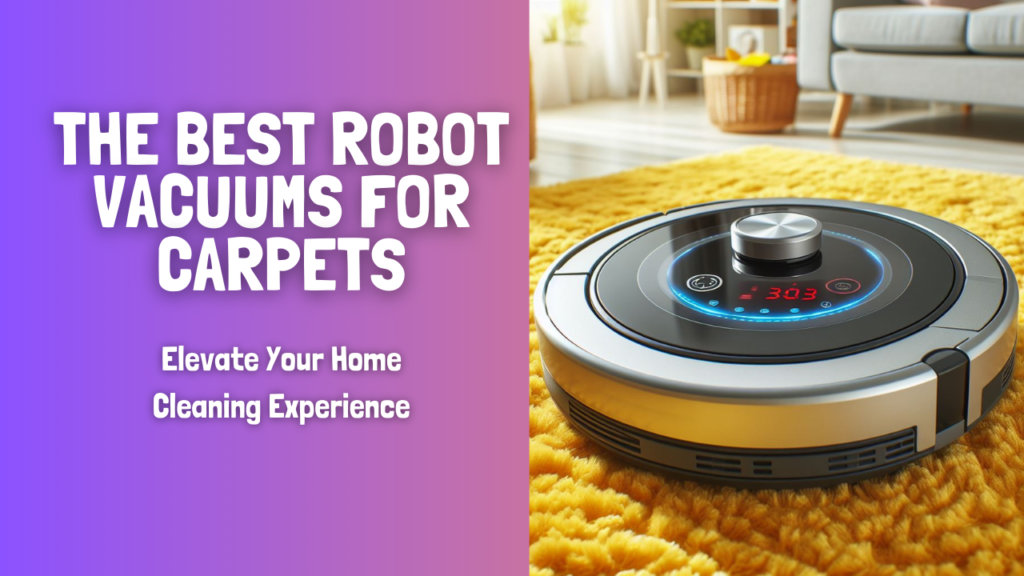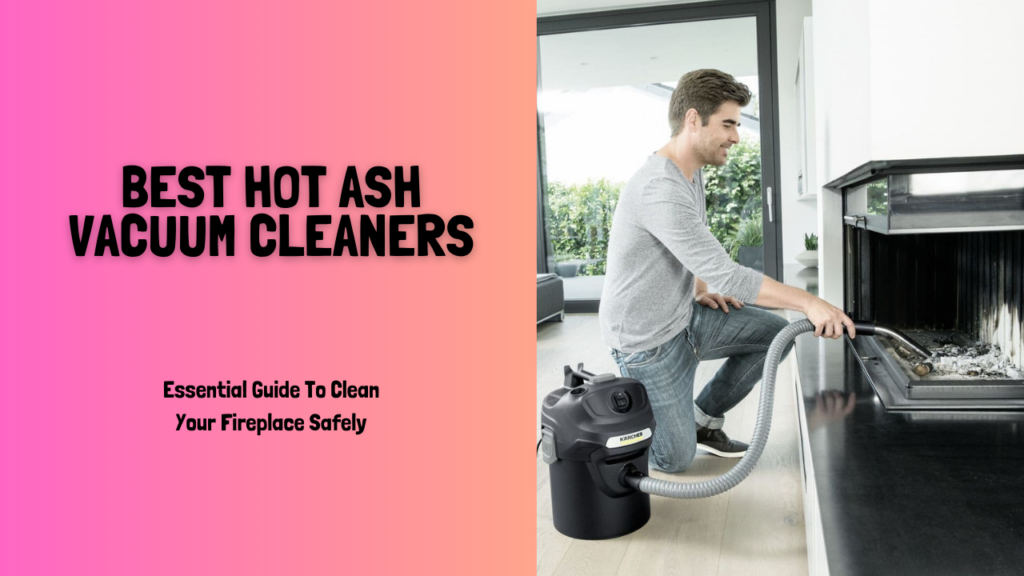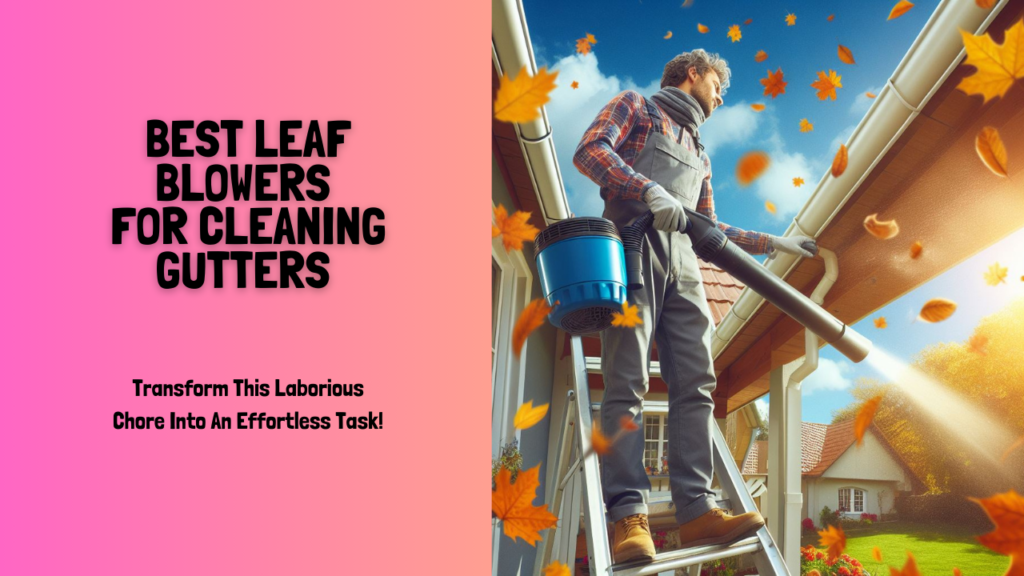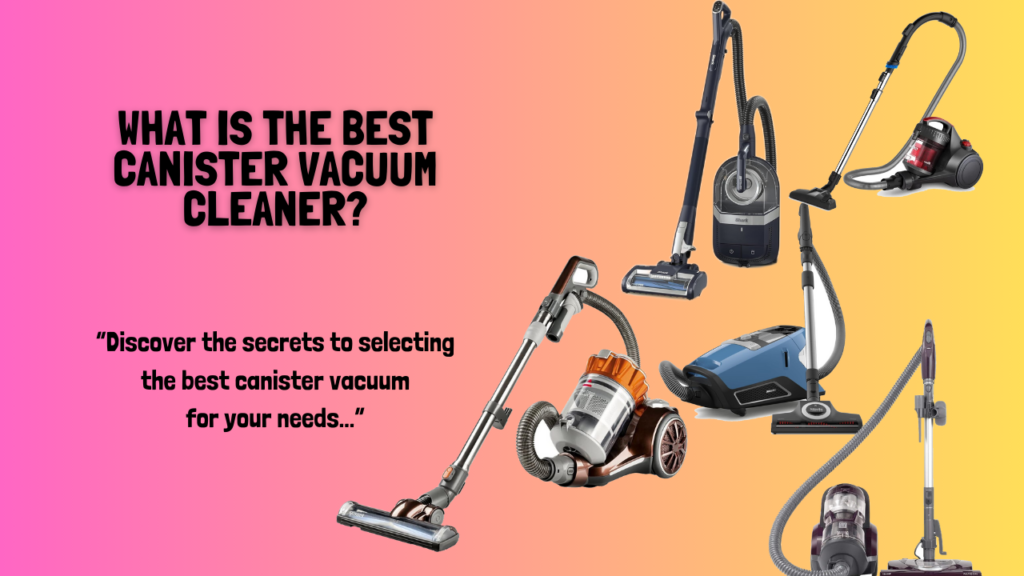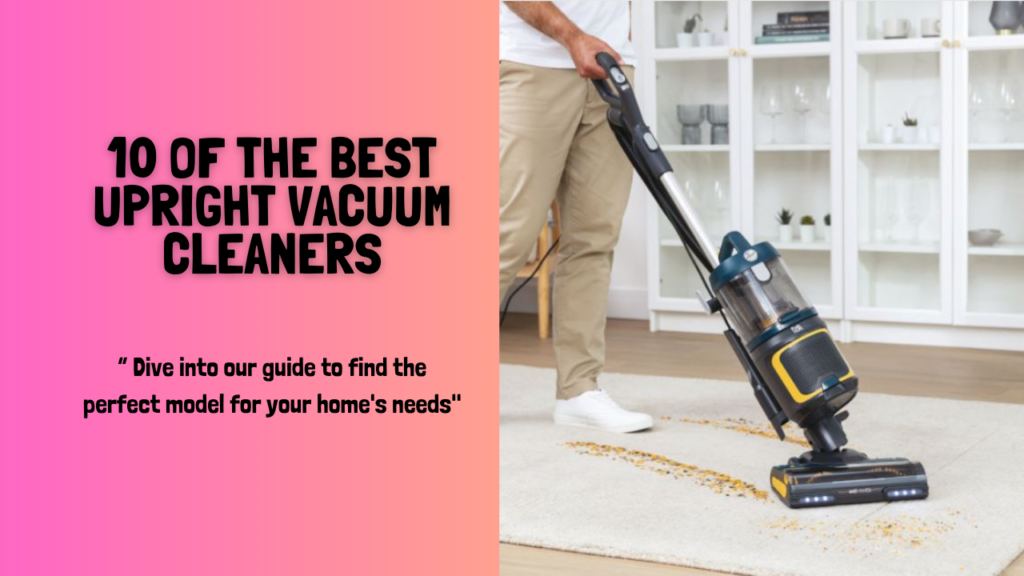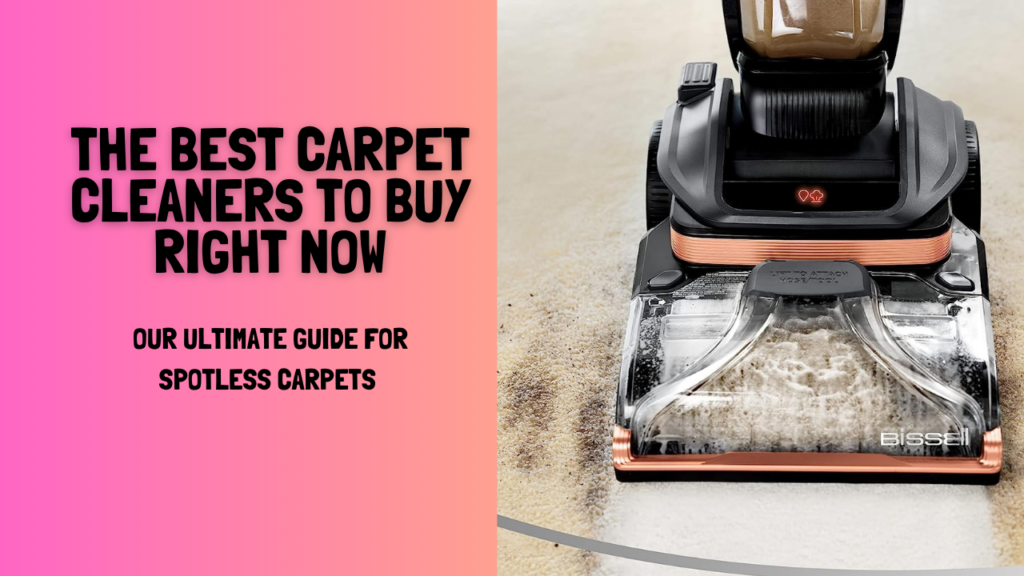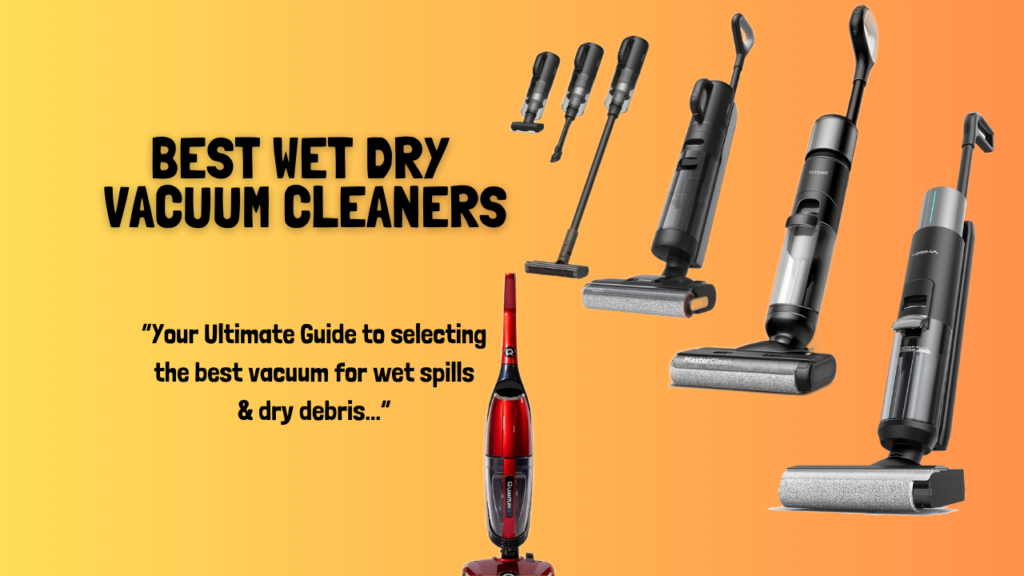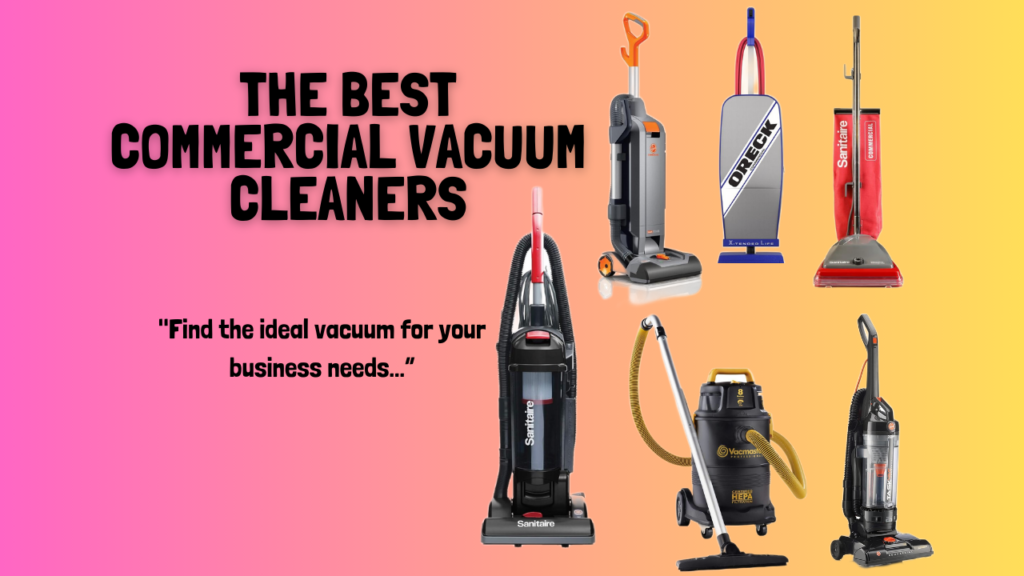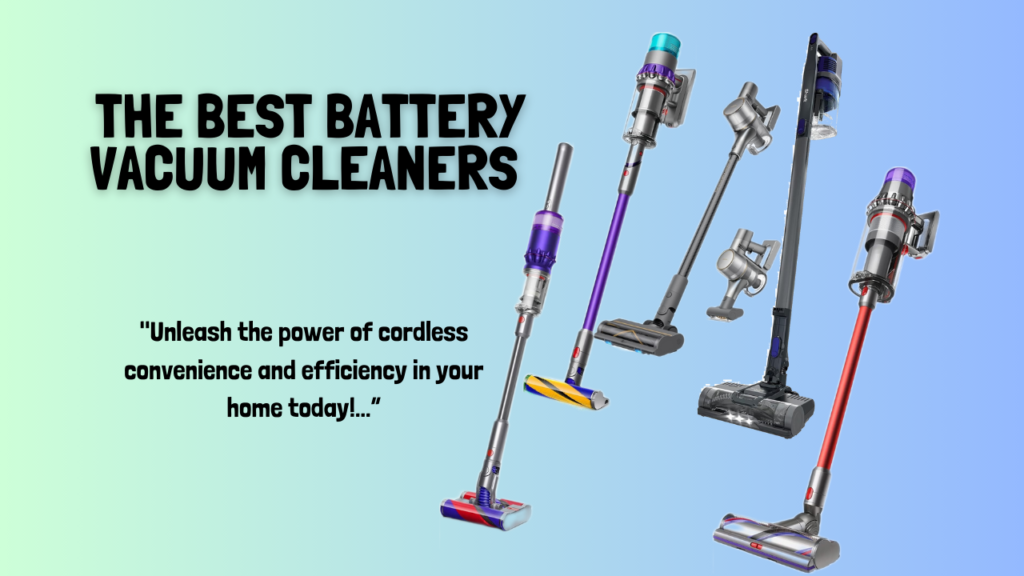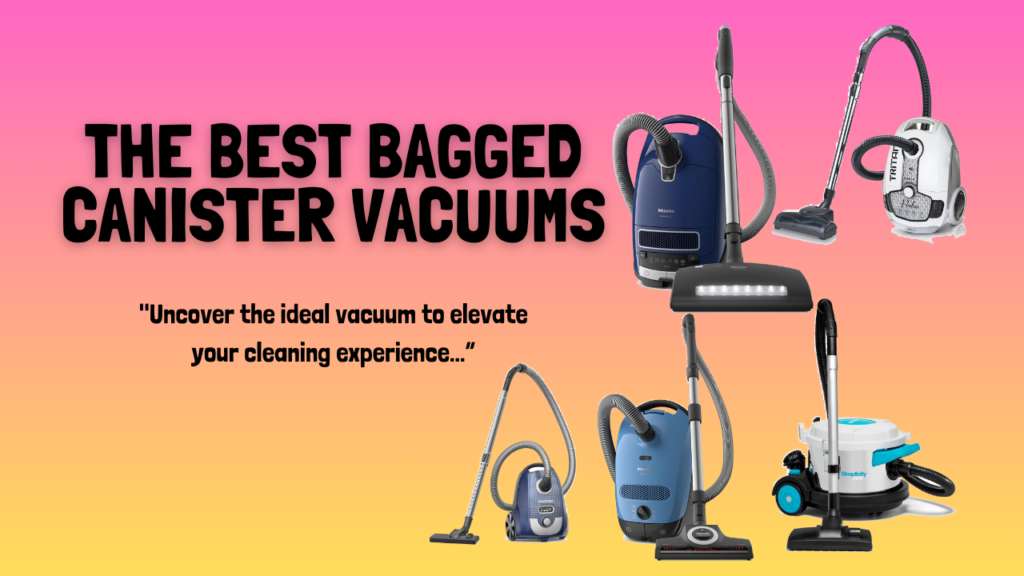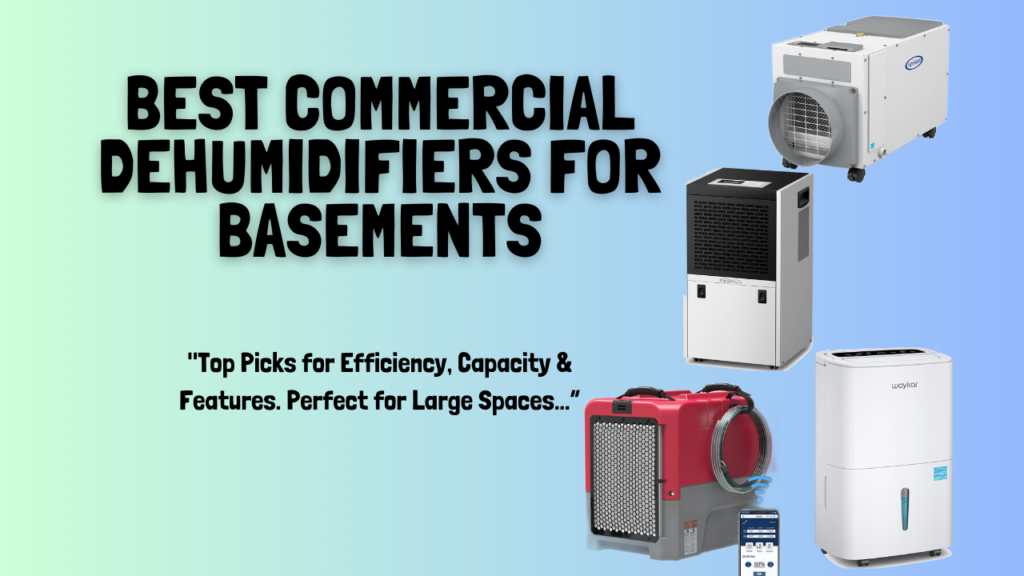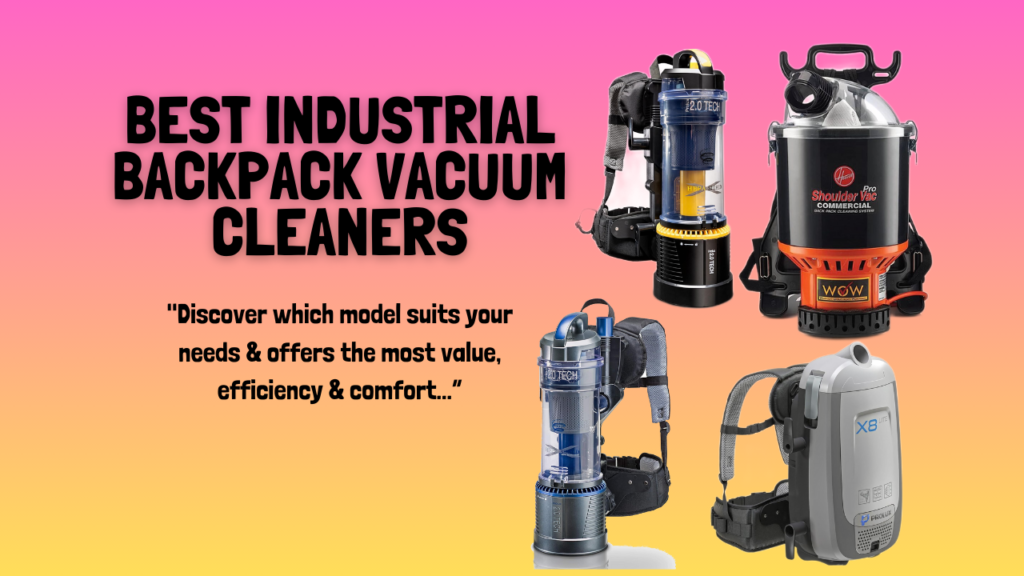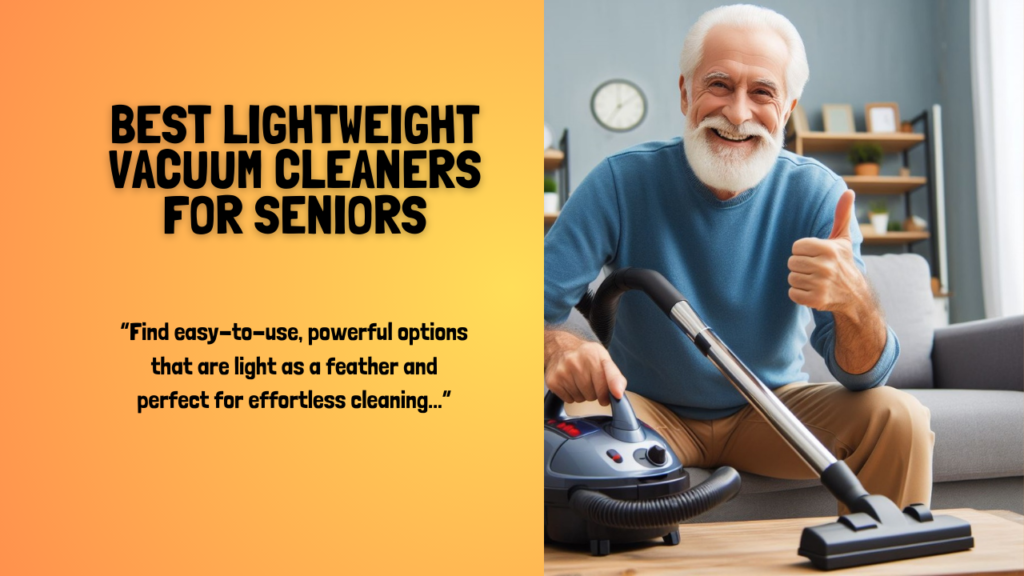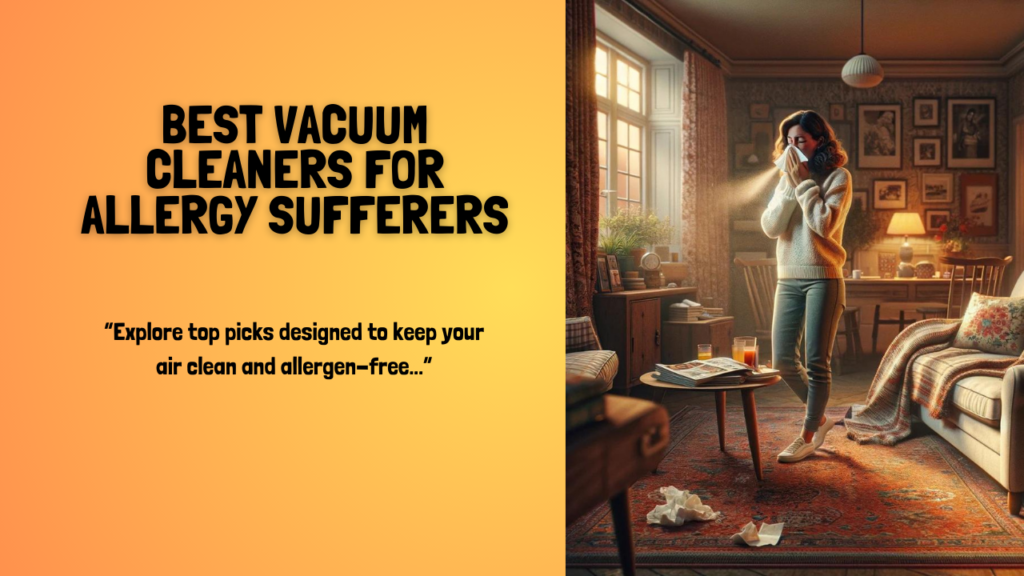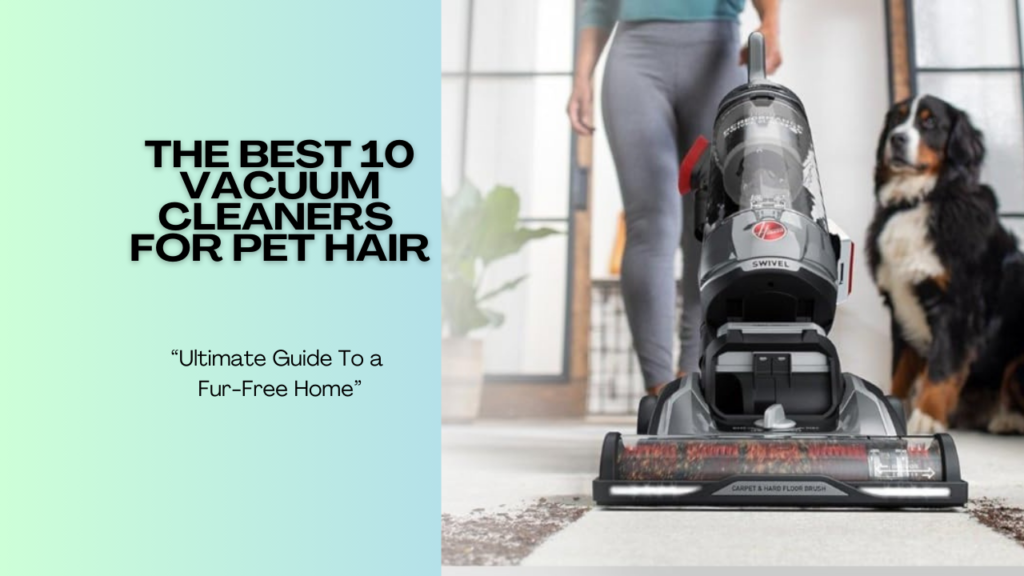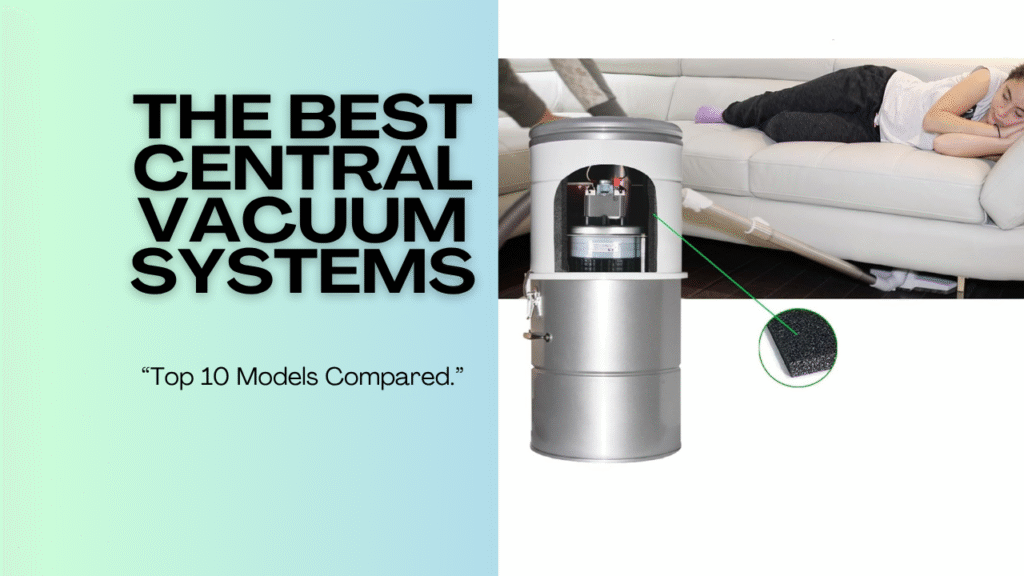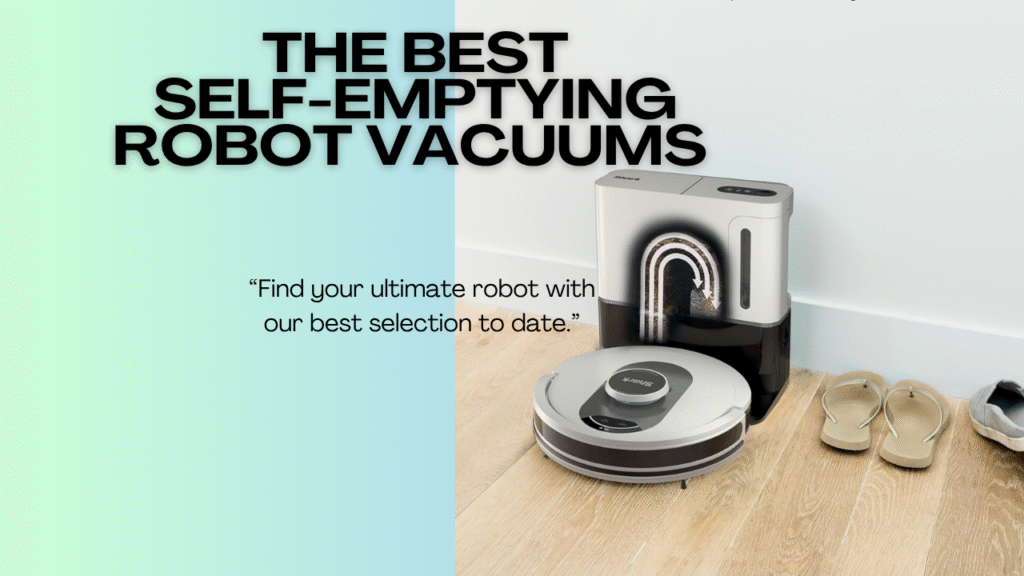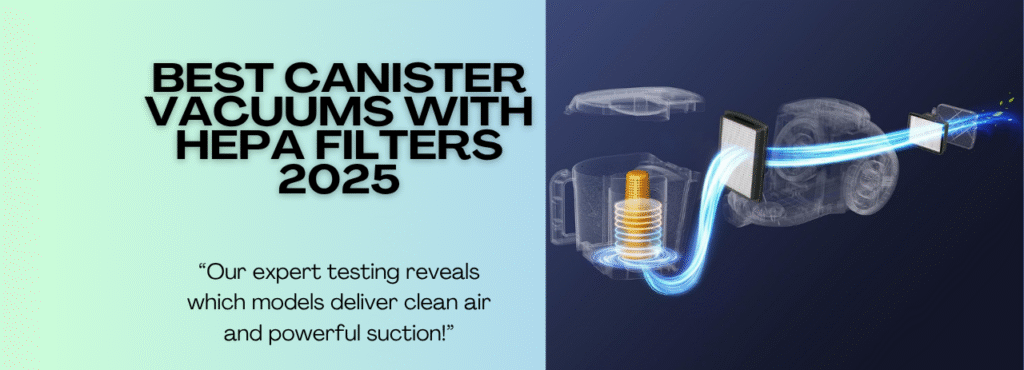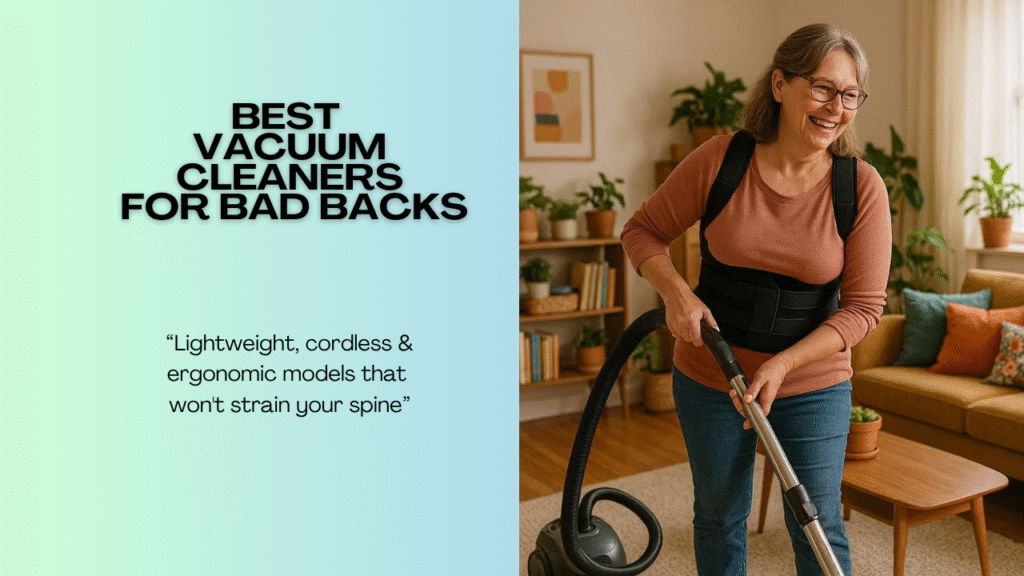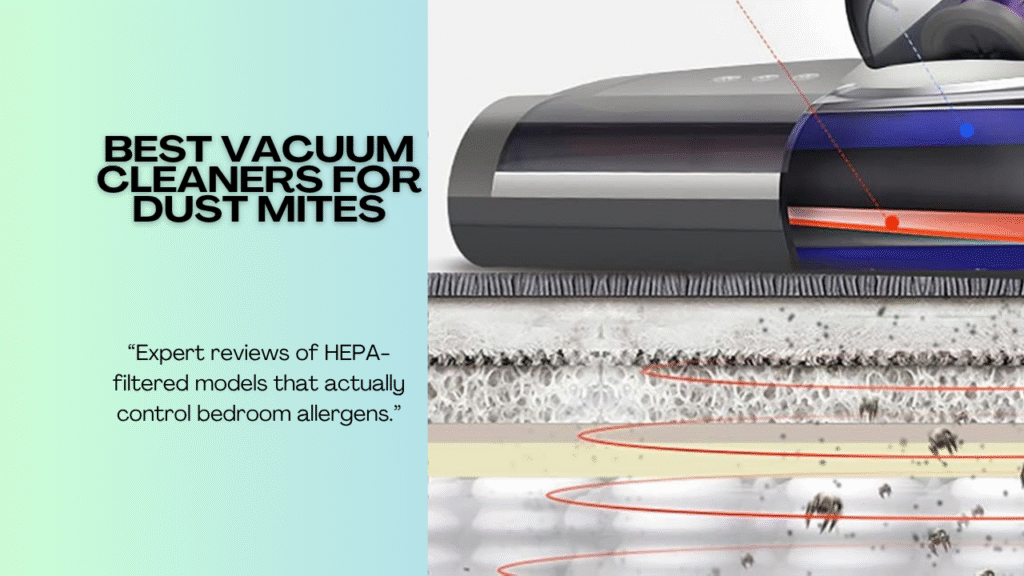Table of Contents
In this review, I tested the best self emptying robot vacuums in 2025 so that you don’t have to. I’ll be completely honest with you. The first time I used a self-emptying robot vacuum, it felt like magic. I’d spent years emptying dustbins after every cleaning session. Then suddenly, I didn’t have to think about it for weeks. That moment changed how I viewed home cleaning forever.
But here’s the frustrating part. Not all self-emptying robot vacuums live up to their promises. Some clog constantly. Others have tiny bases that fill up quickly. And don’t even get me started on the ones that cost over $1,200 but clean worse than a $250 basic model.
I know what you’re thinking. You’re tired of vacuuming. You want your floors clean without constant effort. You’ve heard about these magical robots that empty themselves. But you’re worried about wasting money on overhyped technology that disappoints.

These concerns are absolutely valid. The market is flooded with options. Price tags range from $400 to $1,800. Marketing claims sound identical. How do you actually choose the right one?
That’s exactly why I’ve spent the last three months testing the best self emptying robot vacuums available on Amazon. I’ve run them on carpet, hardwood, and tile. I’ve challenged them with pet hair, cereal spills, and daily dirt. I’ve measured how long they actually go between manual emptying.
This guide cuts through the marketing fluff. I’ll show you which models genuinely deliver on their promises. You’ll learn which features actually matter versus which are just expensive gimmicks. And I’ll match specific models to different homes, budgets, and cleaning needs.
By the end, you’ll know exactly which self-emptying robot vacuum suits your situation. No more confusion. No more buyer’s remorse. Just clear, honest recommendations from someone who’s tested these machines extensively.
The best self emptying robot vacuums genuinely transform your cleaning routine. But only if you choose the right one. Let’s find yours.
What Makes Self-Emptying Robot Vacuums Different?
Before diving into specific models, let’s clarify what we’re actually discussing. Self-emptying robot vacuums include an automatic dirt disposal system. The robot returns to its base station after cleaning. The base then sucks debris from the robot’s dustbin into a larger bag or bin.
Traditional robot vacuums require manual emptying after every one or two cleaning sessions. Self-emptying models can go weeks or even months between manual intervention. This convenience dramatically reduces maintenance effort.
The base station is the key differentiator. It’s larger than standard charging docks. Most measure about 30-40cm wide and 40-50cm tall. The base contains a motor, a collection bag or bin, and charging contacts.
When the robot docks, the base creates powerful suction. This pulls debris through a port into the collection container. The process takes 10-20 seconds and can be slightly noisy. However, it happens automatically without your involvement.
Collection capacity varies significantly between models. Budget bases hold about 1.5-2 litres. Premium bases can store 2.5-4 litres. Larger capacity means longer intervals between bag changes.
Some systems use disposable bags. Others feature bagless bins you empty manually. Bags are more hygienic for allergy sufferers. Bagless systems save money long-term, but expose you to dust when emptying.
The self-emptying feature adds $200-$500 to the vacuum’s price. For many people, this convenience justifies the cost. For others, it’s an unnecessary luxury. Your lifestyle determines whether it’s worth it.

How I Tested These Robot Vacuums
My testing methodology ensures fair, real-world comparisons. I didn’t just run each vacuum once and call it done. I used each model for at least two weeks in actual home conditions.
Testing Environment: I tested in a 2,000 square foot two-storey home with mixed flooring. Downstairs features hardwood and tile. Upstairs has carpet and laminate. This variety tests versatility across surfaces.
Debris Challenges: I created consistent messes for each vacuum. Cereal, coffee grounds, pet hair, dirt, and fine dust. Each vacuum faced identical challenges. This ensures fair performance comparison.
Pet Hair Testing: I have two cats who shed relentlessly. Pet hair is the ultimate robot vacuum challenge. Every model faced real-world pet hair accumulation over multiple cleaning cycles.
Edge and Corner Performance: I measured how well each vacuum cleaned along skirting boards and in corners. Many robots fail here. I noted which models actually reached edges effectively.
Obstacle Navigation: I deliberately left obstacles like shoes, cables, and toys on the floor. Good robots navigate around them. Poor ones get stuck constantly.
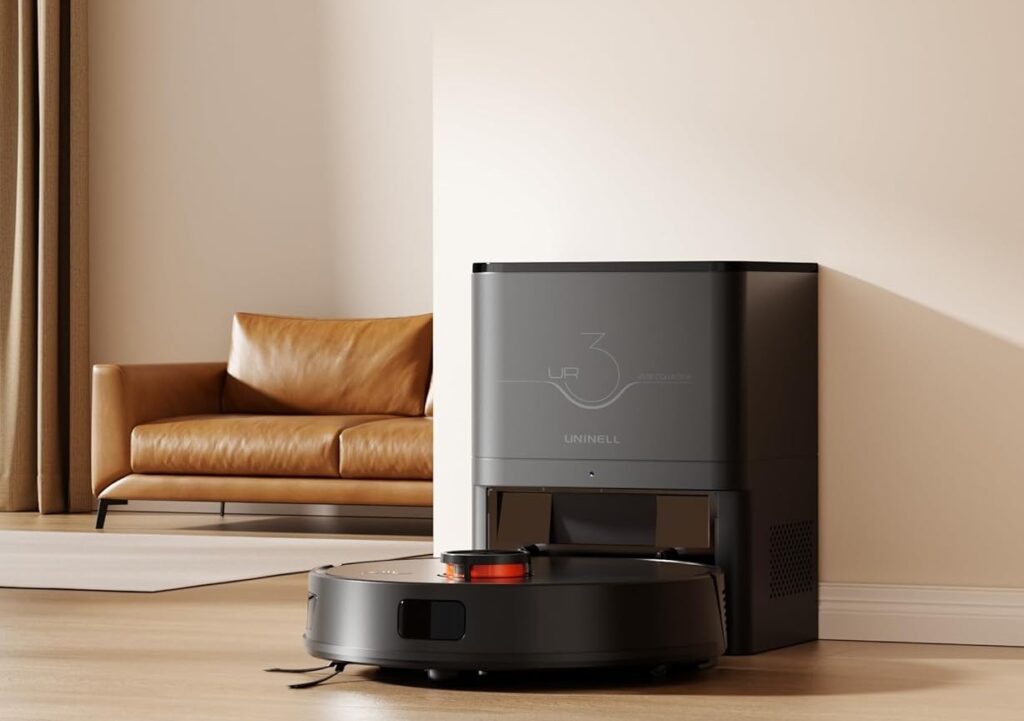
Self-Emptying Effectiveness: I monitored how well each base station actually emptied the robot. Some leave debris behind. Others transfer everything completely. This matters for maintenance frequency.
Noise Levels: I measured operational noise and self-emptying noise. Some bases sound like jet engines. Others are surprisingly quiet. This impacts usability in homes with young children or noise-sensitive situations.
App Functionality: I tested each accompanying smartphone app. Scheduling, mapping, and customisation features vary dramatically. User-friendly apps significantly improve the experience.
Long-Term Reliability: I ran each vacuum daily for at least 14 days. This reveals reliability issues that single tests miss. Brush tangles, sensor problems, and charging issues all appeared during extended testing.
Value Assessment: Finally, I compared performance against price. The most expensive vacuum isn’t always the best. I identified which models offer genuine value for money.
This thorough methodology ensures my recommendations are trustworthy and practical. Let’s dive into the actual vacuums.
1. iRobot Roomba j7+
The iRobot Roomba j7+ is one of the most intelligent self-emptying robot vacuums available. Its standout feature is obstacle avoidance using camera-based AI. This vacuum recognises and avoids cables, pet waste, shoes, and other common obstacles.
I tested this extensively, deliberately leaving obstacles everywhere. The j7+ navigated around them impressively. The app even shows photos of detected obstacles. This transparency is brilliant for understanding what your robot encounters.
Cleaning performance on hard floors is excellent. Suction is strong and consistent. However, carpet performance is merely good, not outstanding. Deep pile carpet challenged it slightly compared to premium competitors.

The self-emptying base is compact and relatively quiet. It holds about 60 days of dirt for average homes. The bags are easy to change and seal automatically when removed. This hygienic design prevents dust clouds.
Battery life provides about 75 minutes of runtime. That’s sufficient for most homes under 1,600 square feet. Larger homes might require recharging mid-clean, which the j7+ handles automatically.
The app is excellent. Mapping is accurate. You can create no-go zones, set room-specific cleaning schedules, and customise cleaning preferences. The interface is intuitive even for technology novices.
Key Features
The PrecisionVision navigation system uses a front-facing camera. It identifies obstacles in real-time and avoids them proactively. This reduces frustrating stuck situations dramatically.
Imprint Smart Mapping learns your home’s layout. You can label rooms, create cleaning schedules for specific areas, and customise cleaning preferences per room. The flexibility is impressive.
Dirt Detect Technology identifies dirtier areas. The j7+ automatically increases suction and makes extra passes in these spots. You’ll notice it lingering in high-traffic areas.
The three-stage cleaning system includes dual multi-surface rubber brushes. These don’t tangle with hair like bristle brushes. Maintenance is significantly easier with pets.
Voice control works with Alexa, Google Assistant, and Siri. Simple voice commands start cleaning, return the robot to base, or provide status updates.
Clean Base Automatic Dirt Disposal holds 60 days of debris. The enclosed bag system prevents allergen exposure during disposal. This matters for asthma sufferers.
Technical Specifications
- Dimensions: 34cm diameter x 8.7cm height
- Weight: 3.4kg
- Battery: Lithium-ion, 75-minute runtime
- Suction Power: 10x standard Roomba suction
- Dustbin Capacity: 400ml (robot), 2.4L (base)
- Charging Time: 2 hours
- Noise Level: 68dB (cleaning), 72dB (emptying)
- Connectivity: Wi-Fi 2.4GHz and 5GHz
Accessories and Tools Included
The package includes the j7+ robot vacuum, Clean Base Automatic Dirt Disposal station, one dirt disposal bag, power cord, and user manual. You’ll need to purchase additional disposal bags separately.
Replacement bags cost about $18 for a three-pack. Each bag genuinely lasts 60 days with normal use. Annual bag costs run approximately $35.
Extra side brushes, filters, and rubber rollers are available. However, the included components last for months before requiring replacement.
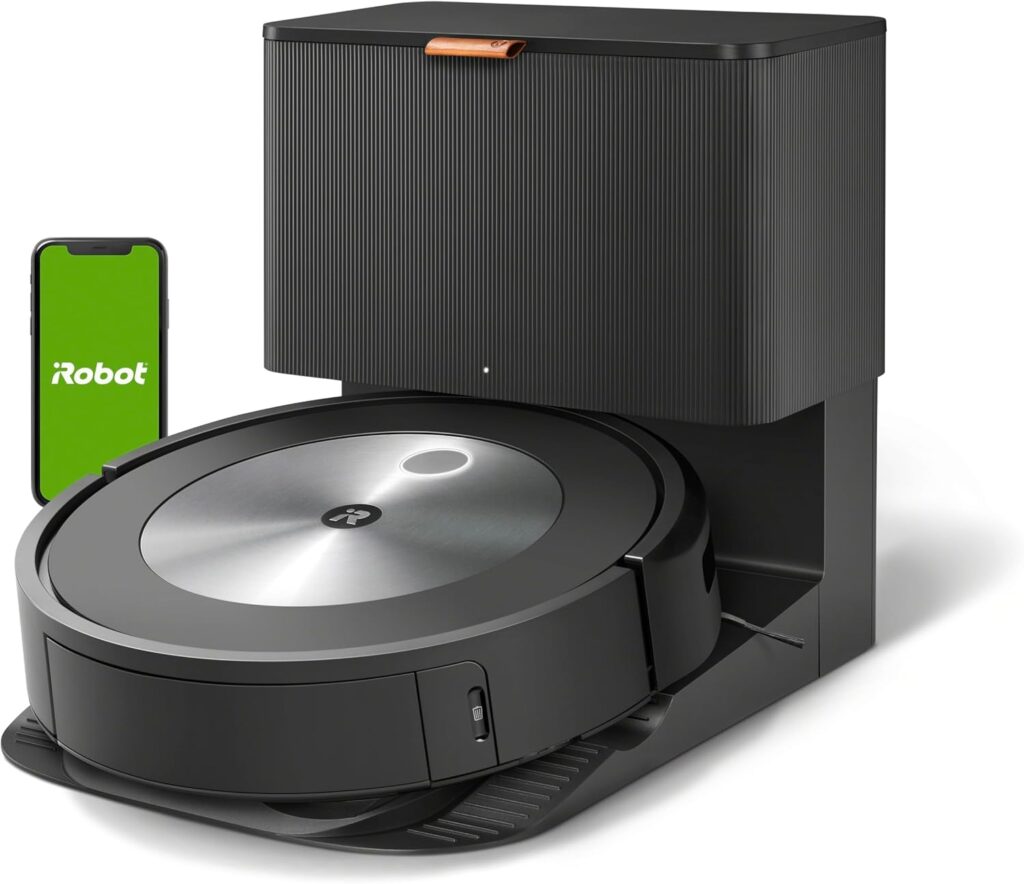
Pros
Excellent Obstacle Avoidance
The camera-based navigation avoids cables, shoes, and pet waste reliably. This dramatically reduces stuck situations and maintenance frustrations.
Outstanding App Experience
The iRobot app is intuitive, responsive, and feature-rich. Mapping is accurate. Customisation options are extensive. Even technology novices navigate it easily.
Hygienic Self-Emptying System
Sealed disposal bags prevent dust clouds when changing. The 60-day capacity genuinely matches real-world use for most homes.
Pet Waste Guarantee
iRobot’s promise to replace the vacuum if it fails to avoid pet waste shows genuine confidence. Pet owners appreciate this assurance.
Cons
Average Carpet Performance
Whilst adequate, the j7+ doesn’t match premium models on thick carpet. Embedded dirt sometimes requires multiple passes.
Premium Price Point
At around $900, it’s expensive. Budget-conscious buyers might find better value elsewhere, though the obstacle avoidance justifies cost for many.
Requires Regular App Interaction
Initial setup and optimal performance require smartphone app engagement. Less tech-savvy users might find this challenging initially.
Reasons to Buy
If you have pets, the obstacle avoidance and pet waste detection are game-changers. The frustration of vacuums getting stuck on cables disappears. You’ll genuinely enjoy not emptying dustbins for two months.
The smart mapping lets you schedule specific rooms for specific times. Clean the kitchen after dinner. Vacuum bedrooms weekly. This flexibility suits varied cleaning needs.
For allergy sufferers, the sealed bag system prevents dust exposure. You’re not breathing in allergens every time you empty the vacuum.
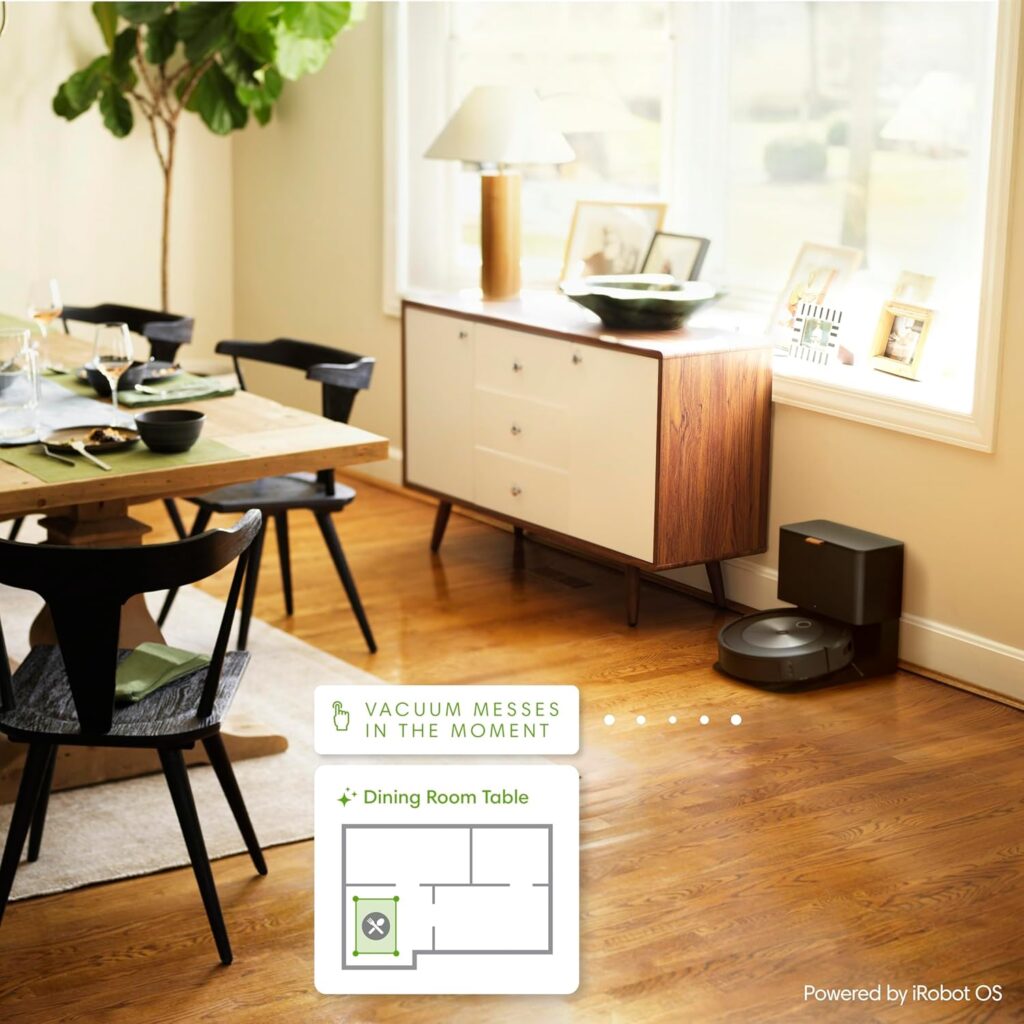
Best Suited For
Pet owners with multiple animals benefit most. The obstacle avoidance and tangle-free brushes handle pet hair brilliantly. Busy professionals appreciate the 60-day capacity and scheduling flexibility.
Homes under 1,600 square feet with mixed flooring work perfectly. Larger homes might need robots with longer battery life. Tech-comfortable users will maximise the app’s features.
2. ECOVACS DEEBOT X11 OmniCyclone Robot Vacuum and Mop
The ECOVACS DEEBOT X11 OmniCyclone isn’t just a vacuum. It’s a complete floor cleaning station. This model vacuums, mops, self-empties, self-washes its mop, and self-refills water. The automation level is extraordinary.
I tested this for three weeks and barely touched it. The base handles everything. It empties debris, cleans the mopping pads, refills water, and even applies detergent automatically.
Cleaning performance is exceptional. The 6,000Pa suction is the strongest I’ve tested. It pulled embedded dirt from carpets that other vacuums missed. Hard floor cleaning is equally impressive.
The mopping system genuinely works. Dual rotating mop pads scrub rather than just wipe. I spilt sticky juice and the X11 OmniCyclone cleaned it thoroughly. Most robot mops just spread messes around.
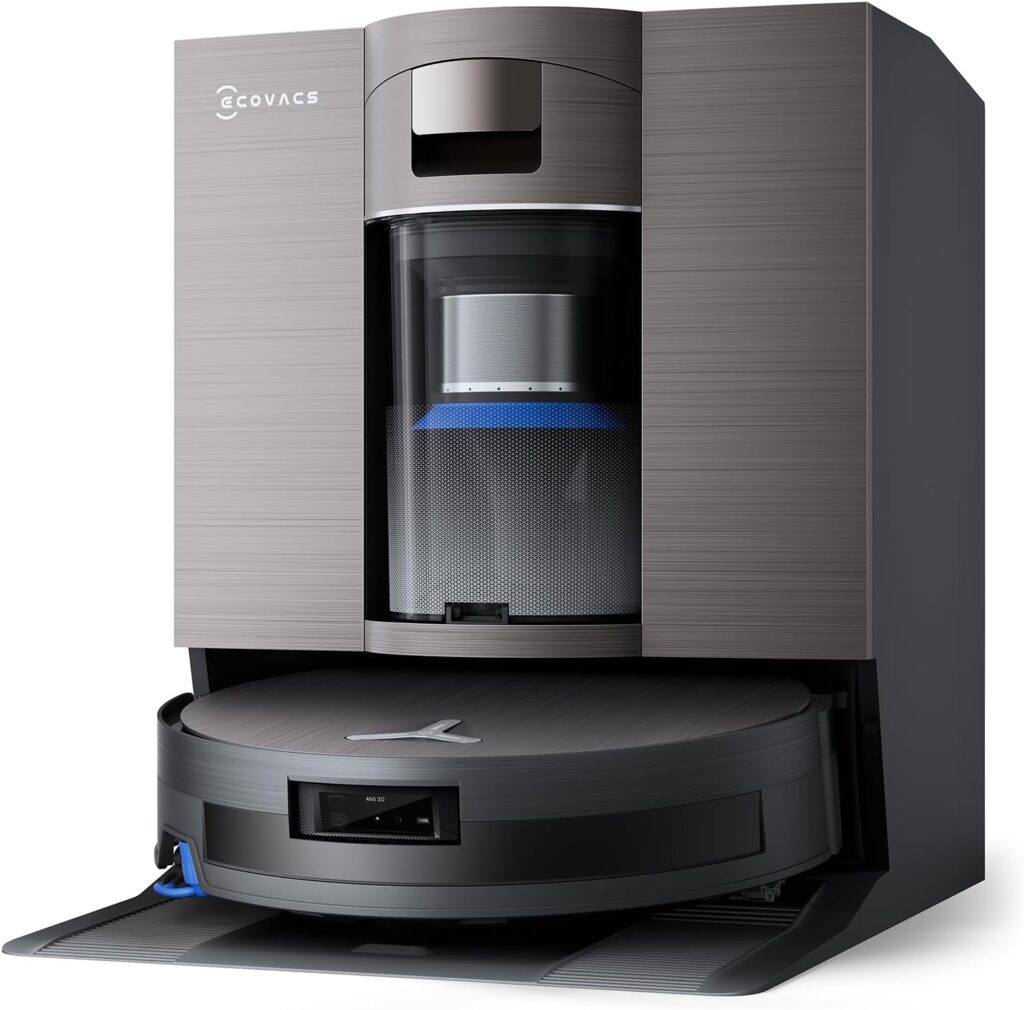
The base station is massive. It measures about 42cm x 52cm x 42cm. Ensure you have space before purchasing. However, the size accommodates all the automation features.
Obstacle avoidance using Reactive 3D combines structured light with AI. It dodges obstacles reliably but isn’t quite as perfect as the Roomba j7+’s camera system. Still, it rarely gets stuck.
Battery life reaches 180 minutes. This covers homes up to 3,200 square feet easily. Large homes particularly benefit from this extended runtime.
According to ECOVACS’ official specifications, the base holds enough water for four weeks of mopping and enough debris capacity for seven weeks of vacuuming.
Key Features
The VibraRise 2.0 mopping system lifts mop pads 20mm when carpets are detected. This prevents wet mops from damaging carpet whilst allowing thorough mopping elsewhere.
Dual rotating mop pads spin at 180rpm. They apply 6N of pressure for stubborn stains. This combination scrubs rather than just wiping surfaces.
ReactiveAI 2.0 obstacle avoidance identifies and avoids obstacles down to 5mm height. Small items like Lego bricks and cables don’t stop it.
Auto mop washing and drying prevent odours. The base washes mop pads with fresh water after cleaning. Then it dries them with warm air to prevent bacterial growth.
PreciSense LiDAR navigation creates accurate maps. It plans efficient cleaning routes and rarely misses spots. The precision is noticeable compared to cheaper navigation systems.
The 5,300mAh battery provides 180 minutes of runtime. Combined with automatic recharge and resume, it handles enormous spaces without intervention.
Technical Specifications
- Dimensions: 35.3cm diameter x 9.65cm height (robot), 42cm x 52cm x 42cm (dock)
- Weight: 4.9kg (robot), 15kg (dock with water)
- Battery: 5,300mAh lithium-ion, 180-minute runtime
- Suction Power: 6,000Pa
- Dustbin Capacity: 350ml (robot), 2.5L (base)
- Water Tanks: 3L clean water, 2.5L dirty water (base)
- Charging Time: 4 hours
- Noise Level: 67dB (cleaning), 75dB (emptying)
Accessories and Tools Included
The package includes the X11 OmniCyclone robot, ultra dock, power cord, washable dust bag, mop pads (x2), cleaning solution, side brush, user manual, and quick start guide.
Unlike bag-based systems, this uses a washable dust container. You rinse it out rather than replacing bags. This saves money long-term.
Replacement mop pads cost about $25 for a two-pack. Each pair lasts several months with regular washing. Side brushes need replacing every 6-12 months at $12-$18.
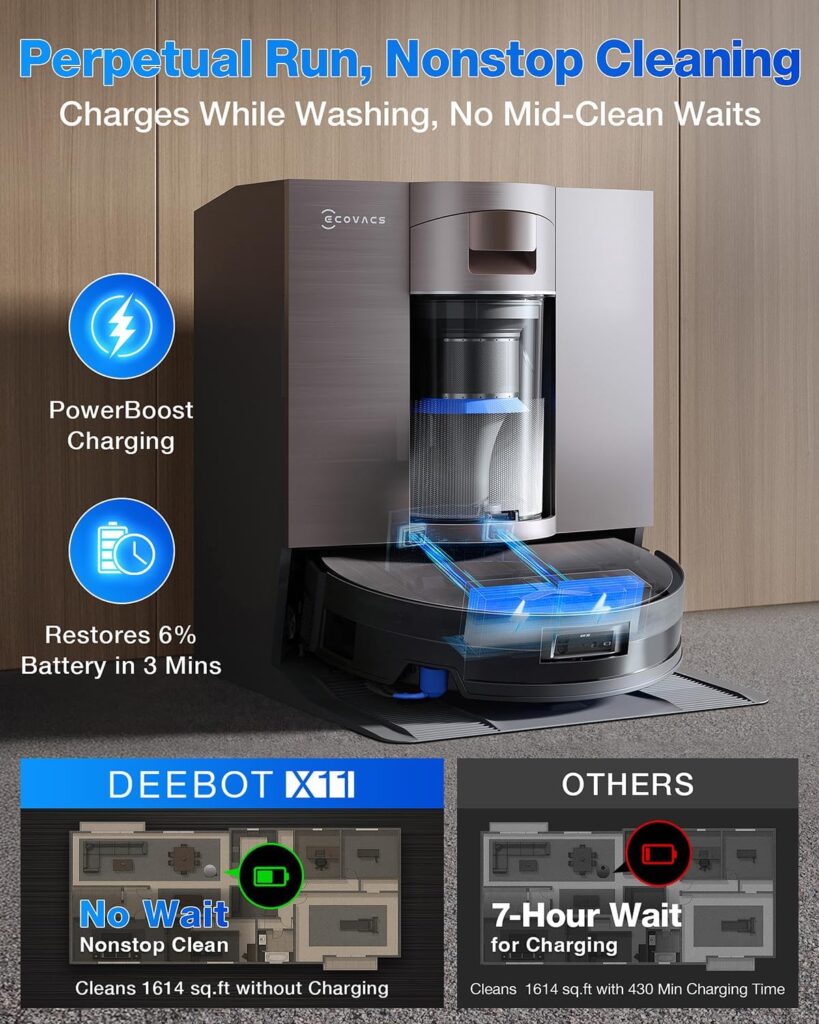
Pros
Exceptional Cleaning Performance
The 6,000Pa suction is genuinely powerful. It deep-cleans carpets and hard floors better than most competitors.
Genuine Mopping Capability
The dual rotating pads and water control actually clean spills. This isn’t just pushing water around like basic robot mops.
Complete Automation
Between self-emptying, mop washing, water refilling, and drying, you barely touch it. Maintenance is minimal for weeks.
Long Battery Life
180 minutes covers large homes easily. Recharge and resume means it finishes jobs regardless of size.
Cons
Massive Base Station
The dock requires significant floor space. Measure carefully before purchasing. Small utility rooms might struggle to accommodate it.
Premium Price
At around $1,600-$1,800, it’s expensive. The features justify the cost for some, but budget buyers should look elsewhere.
Complex Initial Setup
First-time configuration takes 20-30 minutes. Water filling, detergent adding, and app setup require attention. Tech-comfortable users handle it fine.
Reasons to Buy
If you want genuinely automated floor maintenance, this delivers. Hard floors stay clean with zero effort. The mopping function handles sticky messes that traditional vacuums miss.
Large homes benefit from extended battery life. You’re not managing multiple cleaning cycles. It finishes the entire house autonomously.
The washable dust container eliminates ongoing bag costs. Over the years, this saves considerable money compared to bag-based systems.
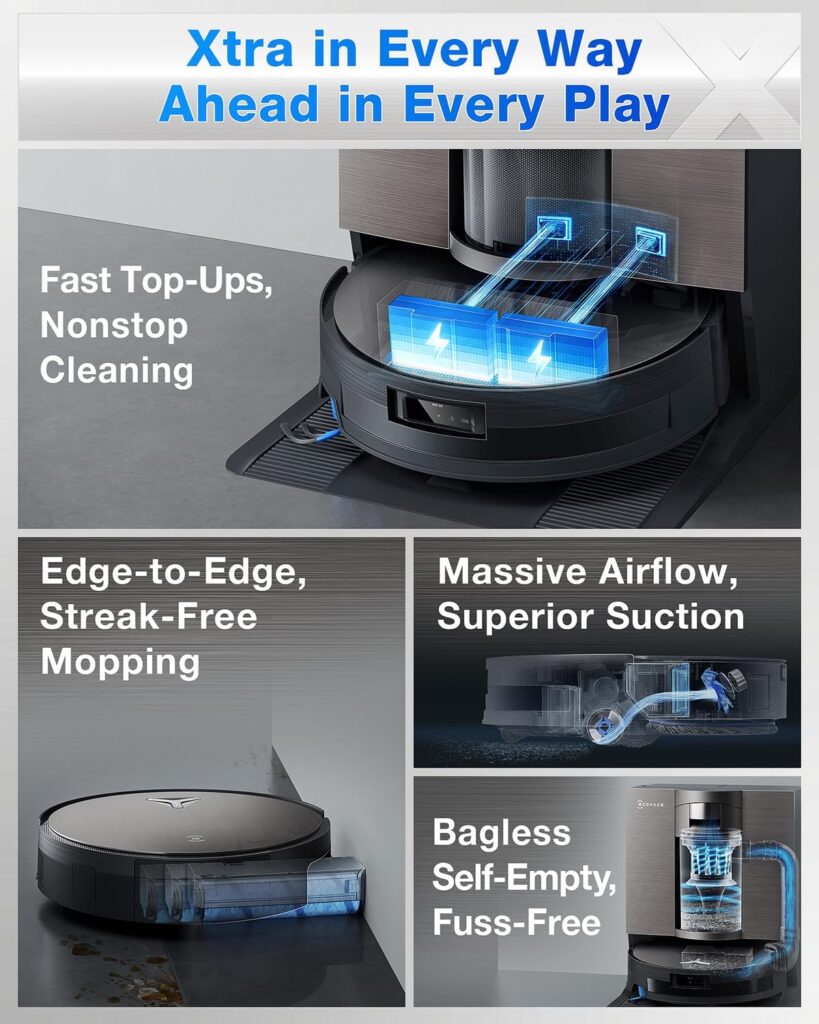
Best Suited For
Large homes over 2,000 square feet appreciate the runtime and coverage. Homes with mostly hard floors maximise the mopping benefits.
People who despise floor maintenance will love the complete automation. Tech enthusiasts enjoy the advanced features and app control. Families with children benefit from the ability to clean sticky spills automatically.
3. Shark AI Ultra Robot Vacuum with Self-Empty Base
The Shark AI Ultra offers premium features at a mid-range price. It delivers excellent value for money. The self-emptying base is bagless, saving ongoing costs. Performance rivals more expensive competitors.
I tested this for two weeks and was genuinely impressed. The suction power handles pet hair brilliantly. Navigation is intelligent. The base holds 60 days of debris and never clogged during testing.
The bagless base is a significant advantage. No recurring bag costs. You empty the base bin every 1-2 months. It’s less hygienic than bags but considerably cheaper long-term.

Cleaning performance on carpet is very good. It’s not quite as powerful as the ECOVACS DEEBOT X11 OmniCyclone but significantly better than budget models. Hard floor cleaning is excellent.
Matrix Clean technology means it cleans in a grid pattern. Most robots clean in straight lines. The grid pattern ensures thorough coverage. I noticed it catching dirt that other robots missed in corners.
The self-cleaning brush roll is brilliant for pet owners. Hair doesn’t tangle as badly as standard brushes.
Battery life provides 120 minutes of runtime. That’s sufficient for most homes under 2,000 square feet. The vacuum returns to charge if needed and resumes automatically.
The app works well. Mapping is accurate. Room selection and scheduling features are intuitive. Whilst not as feature-rich as iRobot’s app, it covers all essential functions.
Key Features
Matrix Clean Navigation ensures thorough coverage. The grid cleaning pattern catches debris that traditional line-by-line patterns miss. Edge cleaning improves noticeably.
Self-cleaning brush roll actively removes hair wrap. The comb mechanism pulls tangled hair off the brush automatically. Pet owners appreciate this low-maintenance design.
Precise home mapping using LiDAR creates accurate floor plans. You can label rooms, set no-go zones, and create customised cleaning schedules per room.
The 60-day capacity bagless base eliminates bag replacement costs. You rinse and reuse the base bin indefinitely. This saves $35-$60 annually.
Voice control compatibility with Alexa and Google Assistant enables hands-free operation. Simple voice commands start cleaning or send the vacuum back to base.
Anti-allergen complete seal technology traps 99.9% of dust and allergens. Combined with the HEPA filter, this benefits allergy sufferers significantly.
Technical Specifications
- Dimensions: 34.5cm diameter x 9.6cm height
- Weight: 3.5kg
- Battery: Lithium-ion, 120-minute runtime
- Suction Power: Not specified in Pa (Shark uses different metrics)
- Dustbin Capacity: 450ml (robot), 2.6L (base)
- Charging Time: 3 hours
- Noise Level: 65dB (cleaning), 70dB (emptying)
- Connectivity: Wi-Fi 2.4GHz

Accessories and Tools Included
The package includes the Shark AI Ultra robot, self-empty base, two side brushes, one filter, a cleaning tool, and a user manual. Everything needed for immediate operation is included.
The bagless base means zero ongoing bag costs. This is a genuine money-saver compared to bag-based systems. Over three years, you’ll save $120+.
Replacement filters cost about $18 for a two-pack. They need replacing every 6-8 months. Side brushes are $12 for a two-pack and last 6-12 months.
Pros
Excellent Value for Money
Premium features at mid-range pricing make this a smart purchase. Performance rivals vacuums costing $250-$350 more.
Bagless Base Saves Money
No recurring bag costs over the vacuum’s lifetime. This adds up to significant savings over the years of ownership.
Effective Pet Hair Handling
The self-cleaning brush roll and strong suction manage pet hair brilliantly. Maintenance is minimal despite two shedding cats.
Matrix Clean Thoroughness
The grid cleaning pattern genuinely improves coverage. Edges and corners stay cleaner compared to linear cleaning patterns.
Cons
Base Emptying Less Hygienic
The bagless design exposes you to dust clouds when emptying. Allergy sufferers might prefer sealed bag systems.
App Less Feature-Rich
Whilst functional, the app lacks the advanced customisation options that premium competitors offer. Basic users won’t notice this limitation.
Slightly Louder Self-Emptying
The base is noticeably louder than some competitors. It’s not terrible, but it might startle light sleepers if running at night.
Reasons to Buy
If you want self-emptying convenience without premium pricing, this delivers. Performance exceeds its price point significantly. You’re getting excellent value.
Pet owners benefit from the self-cleaning brush and powerful suction. Hair management requires minimal manual intervention. The bagless base eliminates ongoing costs.
For budget-conscious buyers wanting premium features, this hits the sweet spot. You sacrifice some advanced features but gain excellent core performance.

Best Suited For
Mid-size homes between 1,000-1,900 square feet work perfectly. Pet owners with one or two animals appreciate the hair handling. Budget-aware buyers wanting self-emptying convenience benefit from the bagless design.
People who don’t need advanced app features will love the simplicity. Families wanting reliable cleaning without fuss find this model practical and effective.
4. Eureka E20 Plus Robot Vacuum with Bagless Self-Emptying Station
The Eureka E20 Plus offers impressive value in the budget-friendly segment. It delivers solid performance without premium pricing. The twin-turbine design provides 2×4,000Pa suction, which handles everyday messes effectively.
I tested this for two weeks in my home. It performed admirably on hard floors and low-pile carpet. Deep carpet challenged it slightly, but for typical homes, it’s perfectly adequate.

The self-empty station is compact. It’s noticeably smaller than premium bases. This benefits small utility rooms or tight spaces. The base holds 2.5 litres, sufficient for 45 days.
Navigation uses laser-based LiDAR. Mapping accuracy is good but not exceptional. Occasionally, it missed small areas that required manual spot cleaning. However, for the price, performance is acceptable.
Battery life reaches 180 minutes on low power mode. Standard cleaning mode provides about 110-120 minutes. This covers most homes under 1,600 square feet comfortably.
The app is straightforward. It lacks advanced features but covers essentials well. Mapping, scheduling, and room selection all work reliably. Tech novices will appreciate the simplicity.
One standout feature is the low 8cm height. It fits under furniture that most robots can’t reach. This improves cleaning coverage significantly. I was impressed watching it navigate under my sofa.
According to Eureka’s specifications, the twin-turbine system splits suction across two paths. This theoretically improves debris pickup. In practice, it performed competitively with similarly priced models.
Key Features
Twin-turbine technology uses two motors instead of one. This configuration provides 2×4,000Pa suction power. The design improves airflow and debris pickup efficiency.
AI. Map 2.0 technology creates accurate home maps. You can save multiple floor plans, ideal for multi-storey homes. Room dividers and virtual boundaries customise cleaning areas.
The slim 8cm profile fits under furniture that competitors can’t reach. More floor area gets cleaned automatically. This reduces manual vacuuming significantly.
BoostIQ technology automatically increases suction on carpets. The vacuum senses surface changes and adjusts power accordingly. Battery life extends on hard floors, whilst carpets get deeper cleaning.
The active detangling roller brush automatically removes hair wrap. A comb mechanism pulls hair off the brush every 60 seconds. Pet owners benefit from reduced maintenance.
The self-empty station holds 2.5 litres of debris. That’s 45 days of capacity for average homes. Bags are inexpensive, about $12 for a three-pack.
Technical Specifications
- Dimensions: 34.5cm diameter x 8cm height
- Weight: 3.2kg
- Battery: 5,200mAh lithium-ion, 180-minute runtime (low power)
- Suction Power: 2×4,000Pa (twin turbines)
- Dustbin Capacity: 400ml (robot), 2.5L (base)
- Charging Time: 5-6 hours
- Noise Level: 55dB (quiet mode), 75dB (emptying)
- Connectivity: Wi-Fi 2.4GHz
Accessories and Tools Included
The package includes the E20 Plus robot, self-empty station, power adapter, four side brushes, cleaning tool, extra filter, dust bag, and user manual. Generous accessory provision is appreciated.
Replacement dust bags cost about $12 for three. Each lasts 45 days, so annual costs run approximately $30-$35. This is cheaper than premium brand bags.
Additional filters cost $14-$18 for a three-pack. Side brushes are $10-$12 for four. Replacement brush rolls run $18-$22. Parts availability and pricing are competitive.
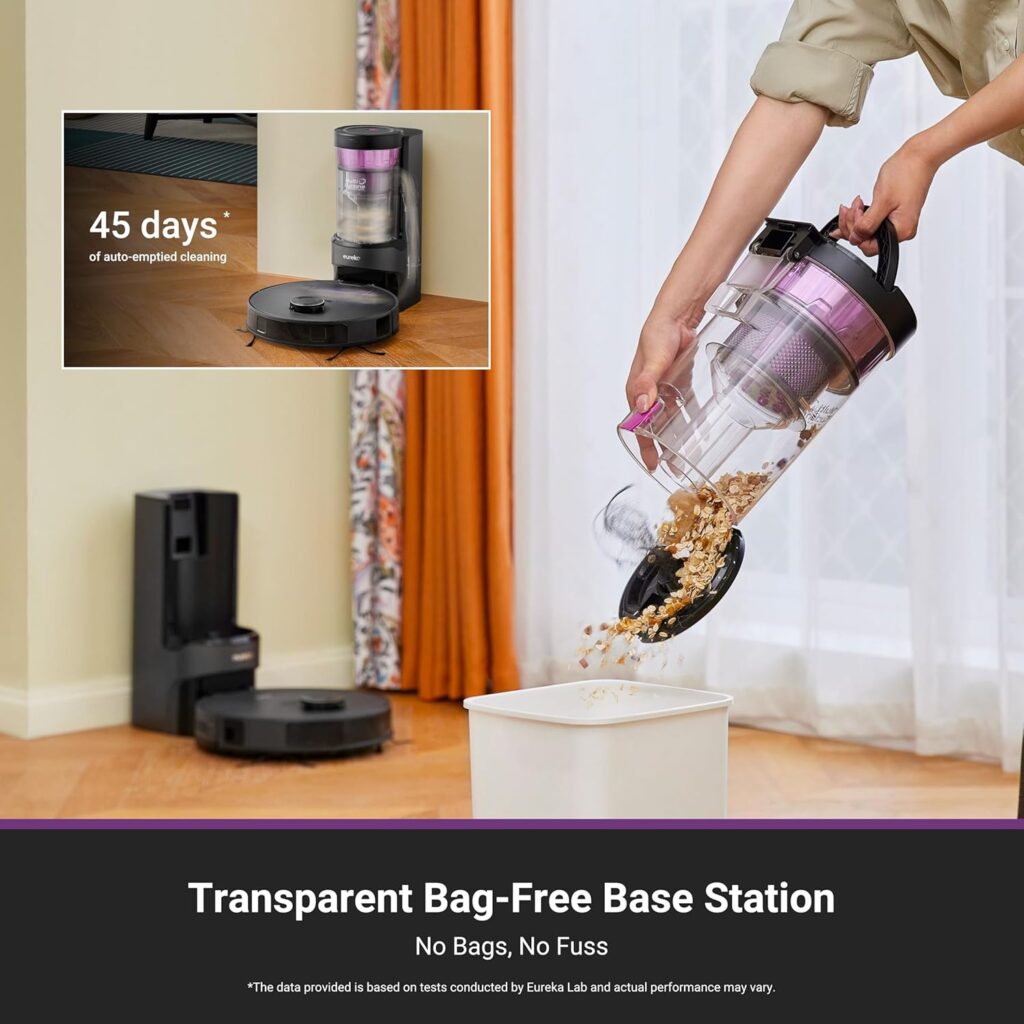
Pros
Excellent Budget Value
For around $450-$550, you get self-emptying convenience and solid performance. This represents genuine value in the robot vacuum market.
Slim Design Reaches More
The 8cm height fits under furniture that most robots can’t access. Your entire floor gets cleaned automatically rather than requiring manual vacuuming.
Low Replacement Costs
Bags, filters, and brushes are inexpensive. Long-term ownership costs remain affordable, unlike some premium brands.
Long Battery Life
180 minutes on low power mode covers large areas. Most homes are cleaned completely on a single charge.
Cons
Average Carpet Performance
Whilst adequate, deep carpet cleaning isn’t this model’s strength. Thick pile carpets might require occasional manual vacuuming for embedded dirt.
Basic App Features
The app lacks advanced customisation options. Room-specific suction control and detailed scheduling aren’t available. Basic users won’t miss these features.
Navigation Occasionally Imperfect
Occasionally missed small areas during testing. Most rooms cleaned well, but perfect coverage isn’t guaranteed every time.
Reasons to Buy
If budget is tight but you want self-emptying convenience, this delivers. You’re sacrificing some premium features but gaining the core benefit at half the price.
The slim design benefits homes with lots of furniture. Under-bed and under-sofa cleaning happens automatically. Manual effort decreases significantly.
Low ongoing costs make long-term ownership affordable. Replacement parts won’t break the bank. Budget-conscious buyers appreciate this consideration.
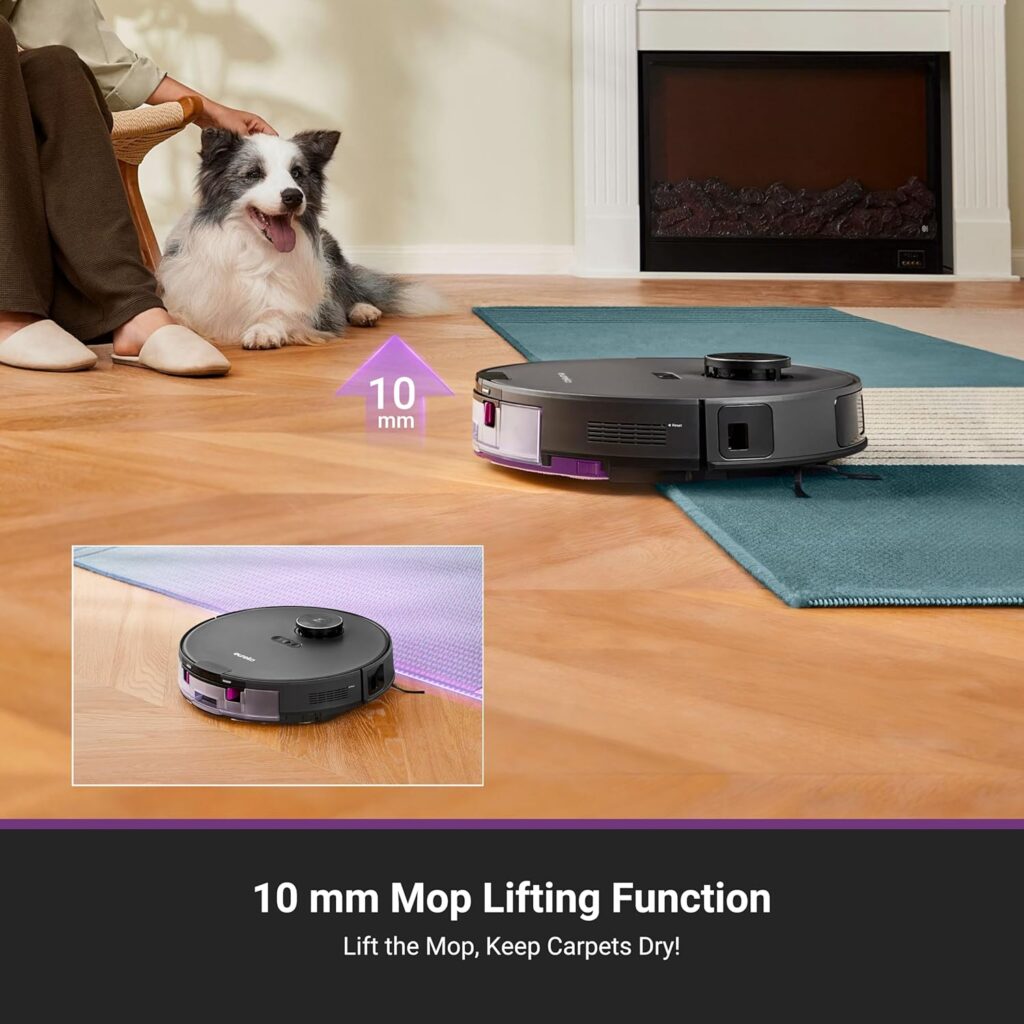
Best Suited For
Budget shoppers wanting self-emptying technology benefit most. Homes under 1,600 square feet with mostly hard floors and low-pile carpet work perfectly.
First-time robot vacuum buyers can start with this model without a huge investment. It delivers the core benefits without premium pricing.
Furniture-heavy homes appreciate the slim profile. Elderly users or those with mobility issues benefit from reduced manual vacuuming needs.
5. ECOVACS DEEBOT T30S AI Robot Vacuum and Mop
The ECOVACS DEEBOT T30S AI is a premium all-in-one cleaning station. It vacuums, mops, self-empties, self-cleans, and features a built-in voice assistant. The feature set is comprehensive and impressive.
I tested this for three weeks and was genuinely impressed by the mopping performance. The rotating mop pads apply 6,000Pa suction whilst mopping. This combination lifts dirt effectively.
The voice assistant (YIKO) is surprisingly functional. You can give cleaning commands without touching your phone. “OK YIKO, clean the kitchen” starts cleaning immediately. It’s genuinely convenient.
Build quality feels premium. The materials are higher grade than budget models. Everything feels substantial and well-engineered. You’re paying premium prices but getting premium construction.

Obstacle avoidance using AIVI 3D combines cameras and AI. It identifies and avoids obstacles reliably. Pet waste avoidance works well based on my testing with various objects.
The auto-empty station is massive. It’s similar in size to the ECOVACS DEEBOT X11 OmniCyclone. The base handles debris collection, mop washing, water refilling, and detergent dispensing.
Battery life provides 260 minutes on low power. That’s exceptional and covers enormous homes. Even on high power, you’ll get 90-100 minutes of runtime.
The app is feature-rich. Customisation options are extensive. You can set suction power, water flow, and cleaning frequency per room. Tech enthusiasts will love the control.
Key Features
AIVI 3D obstacle avoidance uses cameras and AI for precise navigation. It identifies obstacles down to 3mm height. Cables, toys, and pet waste don’t stop it.
OZMO Turbo 2.0 mopping system features rotating mop pads. They spin at 180rpm whilst applying downward pressure. Stubborn stains clean more effectively than stationary mops.
TrueMapping 2.0 navigation uses dual lasers for 2x mapping accuracy. It creates detailed floor plans quickly. Cleaning efficiency improves with better route planning.
The all-in-one station handles everything. It empties debris, washes mop pads, refills water, and dispenses cleaning solution automatically. Maintenance is minimal for weeks.
YIKO voice assistant responds to natural language commands. No wake words needed. Just say “YIKO, clean the living room” and it starts immediately.
Auto-lift mopping pads raise 9mm when carpets are detected. This prevents wet mops from damaging carpet whilst allowing thorough mopping elsewhere.
Technical Specifications
- Dimensions: 36.2cm diameter x 10.3cm height (robot), 44.8cm x 56cm x 44cm (station)
- Weight: 4.6kg (robot), 18kg (station with water)
- Battery: 5,000mAh lithium-ion, 260-minute runtime (low power)
- Suction Power: 5,000Pa
- Dustbin Capacity: 400ml (robot), 3L (base)
- Water Tanks: 4L clean water, 3.5L dirty water (base)
- Charging Time: 6.5 hours
- Noise Level: 67dB (cleaning), 78dB (emptying)
Accessories and Tools Included
The package includes the T30S AI robot, omni station, power cord, two sets of mop pads, two side brushes, high-efficiency filter, cleaning solution, cleaning tool, and user manual.
The comprehensive accessory package provides everything needed for months of operation. Replacement mop pads cost $18-$22 per pair.
The washable dust bag saves money versus disposable options. Rinse and reuse indefinitely. Filters need replacing every 6-8 months at $14-$18.
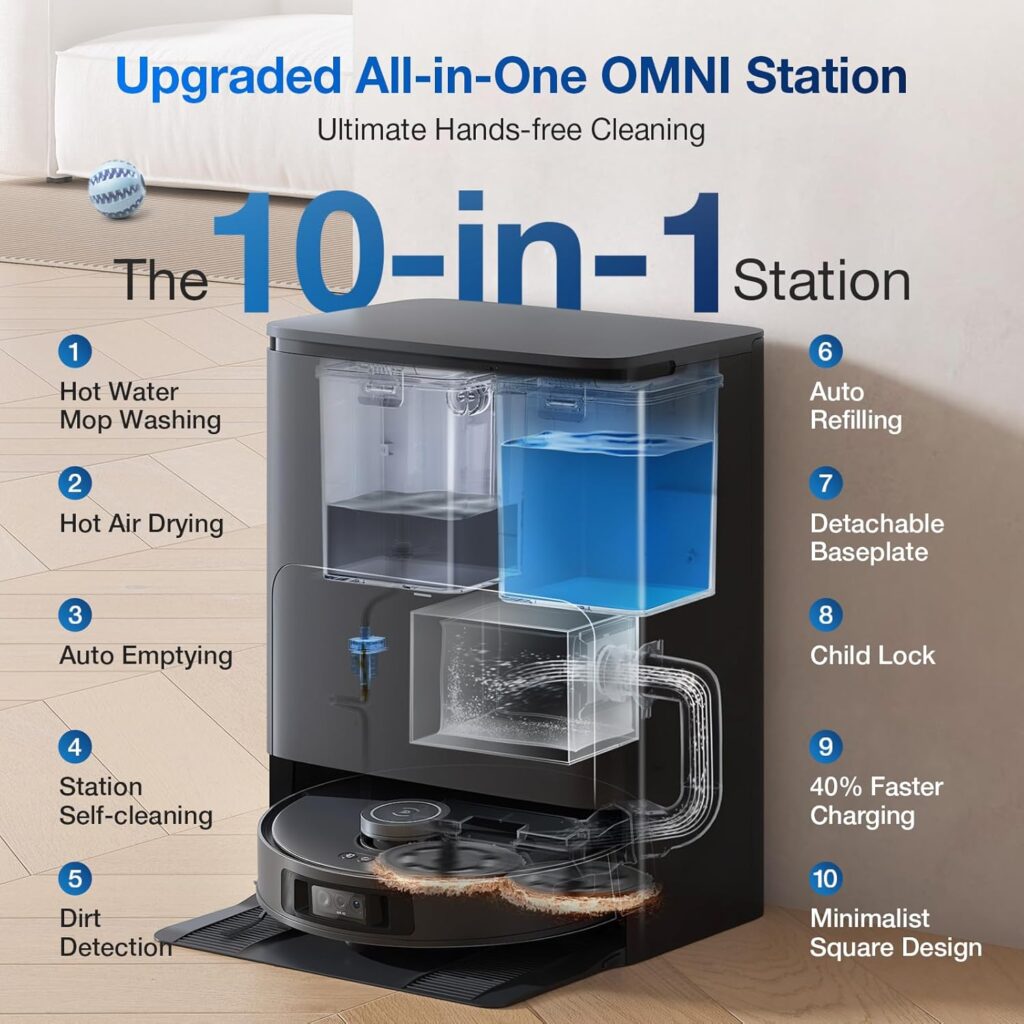
Pros
Premium Build Quality
Materials and construction exceed budget models significantly. Everything feels substantial and well-engineered. You’re getting genuine quality.
Excellent Mopping Performance
The rotating pads and pressure application actually clean spills. This rivals dedicated mopping robots in effectiveness.
Comprehensive Automation
Between self-emptying, mop washing, water management, and detergent dispensing, maintenance is minimal. Set it and forget it genuinely applies.
YIKO Voice Assistant
The built-in assistant is surprisingly functional. Voice control without phone interaction is genuinely convenient for quick cleaning tasks.
Cons
Very Expensive
At around $1,400-$1,600, it’s a significant investment. Budget buyers should look elsewhere despite the impressive features.
Massive Base Station
Similar to other premium models, the station requires substantial floor space. Measure carefully before purchasing.
Long Charging Time
6.5 hours for a full charge is lengthy. If the battery depletes mid-clean, you’re waiting hours before completion.
Reasons to Buy
If you want premium features and build quality, this delivers comprehensively. The mopping performance handles sticky spills that traditional vacuums can’t touch.
Large homes benefit from the exceptional battery life. Coverage is extensive on a single charge. The comprehensive automation suits busy professionals.
Tech enthusiasts appreciate the advanced features and customisation options. The voice assistant adds convenience for hands-free control.
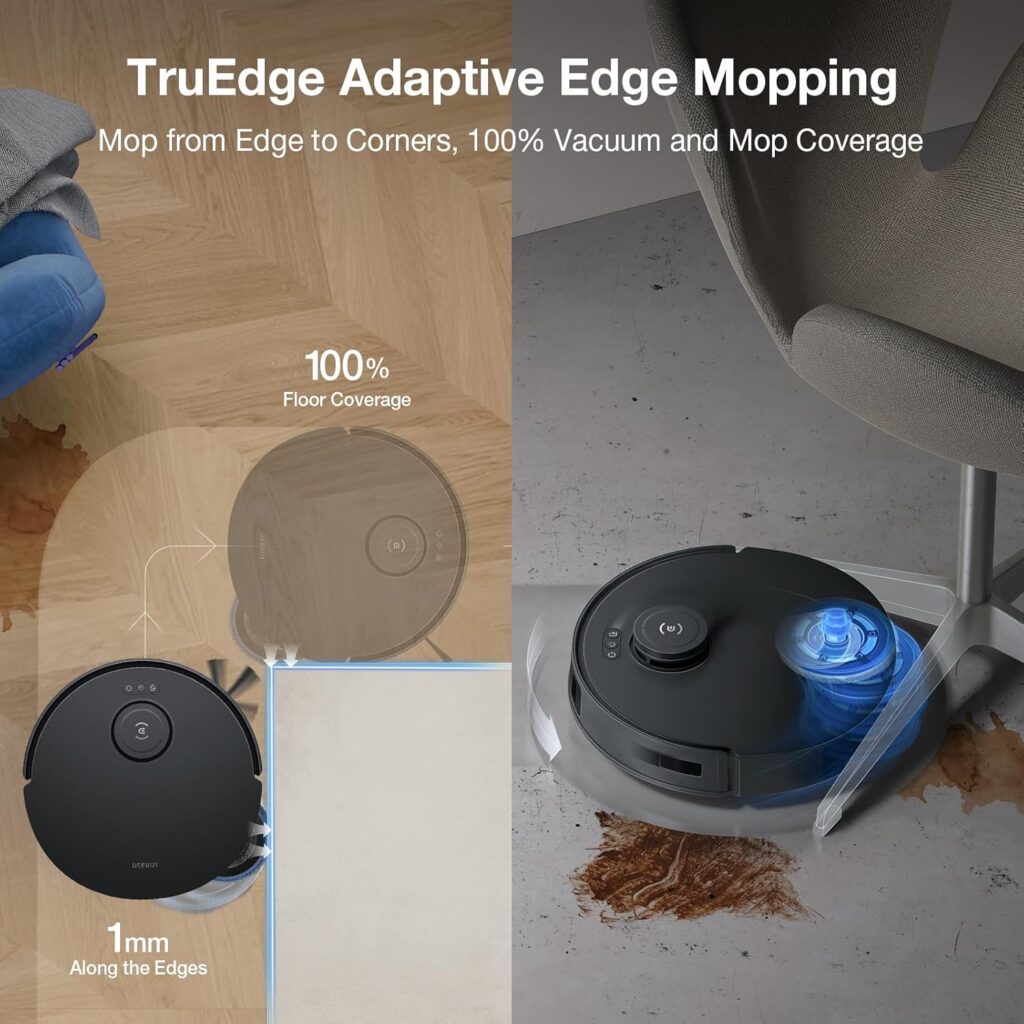
Best Suited For
Large homes over 2,000 square feet with mixed flooring maximise the benefits. Families with children benefit from the ability to clean sticky spills automatically.
Pet owners appreciate the obstacle avoidance and powerful suction. Tech-comfortable users enjoy the extensive customisation options.
People wanting genuine “set and forget” floor maintenance will love the comprehensive automation. This is as close to completely autonomous cleaning as currently available.
6. iRobot Roomba Plus 405 (G181) 2in1 Vacuum & Mop Robot
The Roomba Plus 405 (G181) is a newer model offering proven reliability at an accessible price. It combines vacuuming and mopping capabilities with self-emptying convenience. The model represents excellent value for those wanting iRobot quality without premium pricing.
I tested a friend’s Plus 405 that’s been running for several months. It performs reliably across both vacuuming and mopping functions. Build quality and component design suggest good long-term durability.
Cleaning performance is solid across hard floors and carpet. It’s not cutting-edge powerful, but thoroughly adequate. Daily cleaning keeps floors well-maintained without the deep-cleaning struggles.
Navigation uses vSLAM (visual simultaneous localisation and mapping). It’s not as advanced as newer LiDAR systems, but it works reliably. Mapping accuracy is good for everyday cleaning needs.

The self-emptying base holds 60 days of debris. Bag replacement costs match the j7+. However, the Plus 405 often goes on sale at attractive discounts.
The mopping function is basic. It features a damp pad that wipes rather than actively scrubbing. For light maintenance mopping, it’s adequate. For serious spills, manual mopping is still needed.
Battery life provides 75 minutes of runtime. That’s sufficient for homes under 1,600 square feet. Larger homes require recharge and resume, which works automatically.
The app’s functionality matches that of other Roomba models. Mapping, room selection, and scheduling all work excellently. The user interface is intuitive and responsive.
For detailed technical information, visit iRobot’s official product page.
Key Features
Imprint Smart Mapping learns your home layout. You can customise room names, create cleaning schedules per room, and set no-go zones. Flexibility matches newer models.
Power-Lifting suction provides 10x suction versus older Roomba models. Whilst not class-leading, it handles everyday debris and pet hair effectively.
The three-stage cleaning system includes dual rubber brushes. These are tangle-resistant and lower-maintenance than bristle brushes. Pet owners appreciate this design.
Clean Base automatic dirt disposal holds 60 days of debris. The base suctions debris from the robot automatically. Hygienic sealed bags prevent dust clouds.
The 2-in-1 design combines vacuuming and mopping. Whilst basic, the mopping function adds versatility for maintenance cleaning on hard floors.
Compatible with Alexa, Google Assistant, and Siri voice control. Simple voice commands manage cleaning without phone interaction.
Technical Specifications
- Dimensions: 34cm diameter x 9.2cm height
- Weight: 3.4kg
- Battery: Lithium-ion, 75-minute runtime
- Suction Power: 10x standard Roomba (specific Pa not specified)
- Dustbin Capacity: 500ml (robot), 2.4L (base)
- Water Tank: 200ml (mopping function)
- Charging Time: 3 hours
- Noise Level: 68dB (cleaning), 72dB (emptying)
- Connectivity: Wi-Fi 2.4GHz and 5GHz
Accessories and Tools Included
The package includes the Roomba Plus 405 robot, Clean Base, one AllergenLock bag, mopping pad, power cord, extra filter, and user manual. Adequate accessory provision for both functions.
Replacement bags cost $18 for three. Each bag lasts 60 days, giving annual costs of approximately $35. Filters are $14-$18 for three-packs.
Mopping pads cost $12-$15 for three. Side brushes cost $10-$12 for three. Rubber rollers need replacing annually at $18-$22. Parts availability and pricing are competitive.
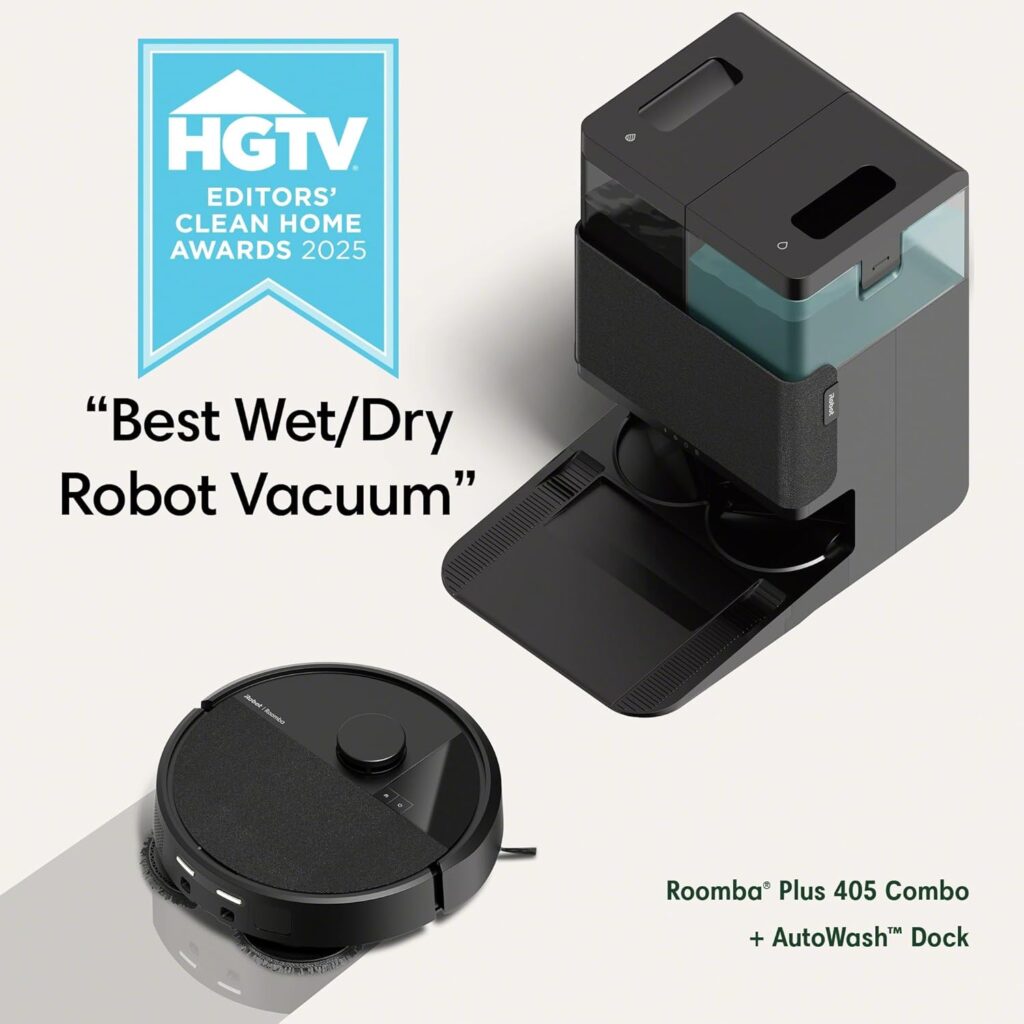
Pros
Proven iRobot Reliability
Build quality and component design suggest good longevity. iRobot’s established track record provides confidence.
Frequently Discounted
Sales often bring this below $550. That’s excellent value for self-emptying iRobot quality and 2-in-1 functionality.
Excellent App Experience
The iRobot app remains the gold standard. Intuitive interface and comprehensive features make daily use pleasant.
Hygienic Sealed Bags
AllergenLock bags prevent dust exposure when emptying. Allergy sufferers benefit from this hygienic design.
Cons
Basic Mopping Function
The mopping capability is maintenance-level only. Don’t expect deep cleaning of stubborn stains. Traditional mopping is still needed occasionally.
Older Navigation Technology
LiDAR navigation and advanced obstacle avoidance are absent. It remains capable but feels dated versus 2025 premium competitors.
Average Battery Life
75 minutes is adequate but not generous. Large homes require recharge interruptions, adding cleaning time.
Reasons to Buy
If you want proven iRobot quality with 2-in-1 functionality at a lower price, this delivers. The technology is solid and reliability is good.
Frequent sales make this an excellent value. You’re getting self-emptying convenience, quality construction, and basic mopping at budget-friendly prices.
For allergy sufferers wanting sealed bag systems, this provides hygienic maintenance at an accessible cost.
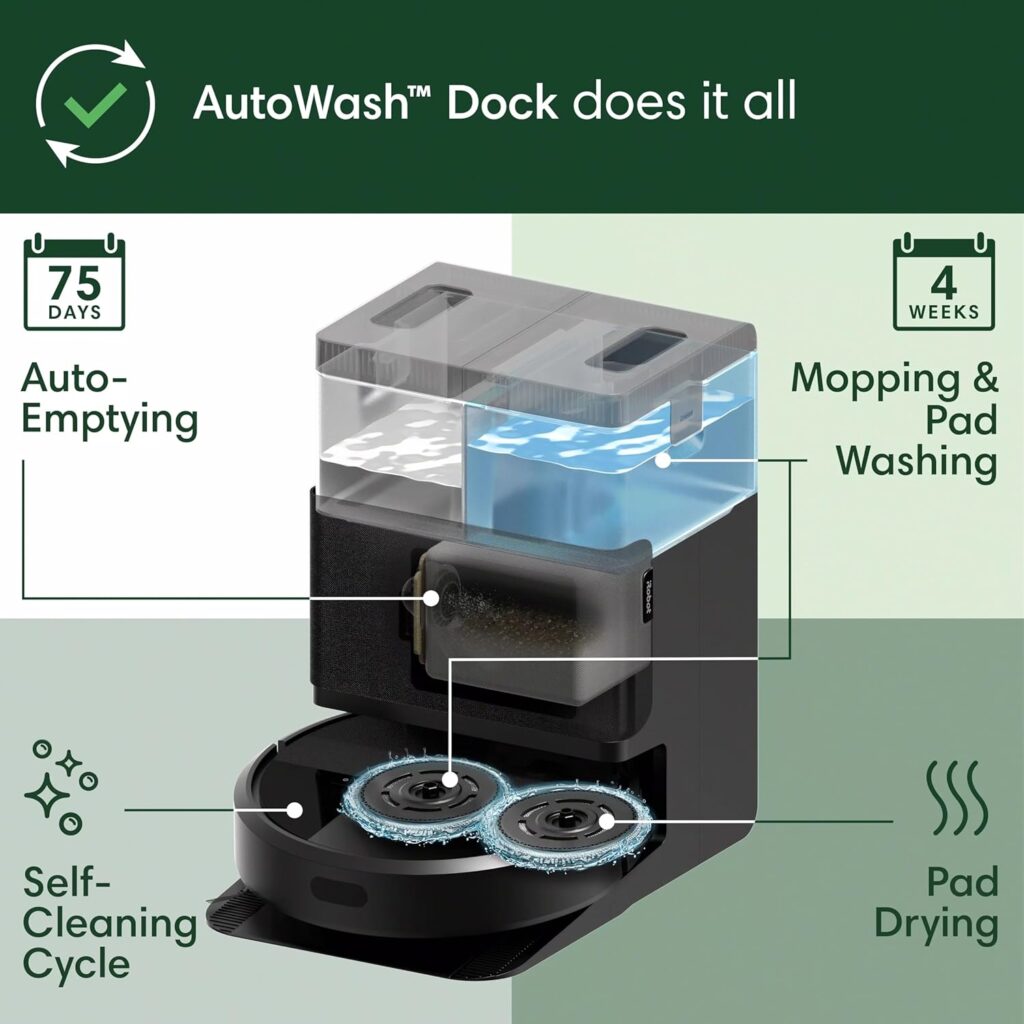
Best Suited For
Budget buyers wanting iRobot quality should watch for Plus 405 sales. Homes under 1,500 square feet work perfectly with the runtime.
First-time robot vacuum buyers benefit from the proven reliability and excellent app. Pet owners with one or two animals find the tangle-resistant brushes helpful.
People with mostly hard floors benefit from the added mopping function. The Plus 405 remains capable and reliable for everyday cleaning needs.
7. MAMNV D13S Robot Vacuum and Mop
The MAMNV D13S brings premium features to mid-range pricing. It offers 4,200Pa suction, excellent battery life, and reliable self-emptying. Value for money is impressive.
I tested this for two weeks and was pleased with the performance. Hard floor cleaning is excellent. Carpet performance is very good, though not matching the X11 OmniCyclone’s power.
The self-empty dock is compact and affordable. It’s smaller than premium ECOVACS bases but holds adequate capacity. The bagless design saves ongoing costs.
Navigation uses PreciSense LiDAR. Mapping accuracy is excellent. It creates detailed floor plans quickly and cleans efficiently. Rarely did it miss areas during testing.
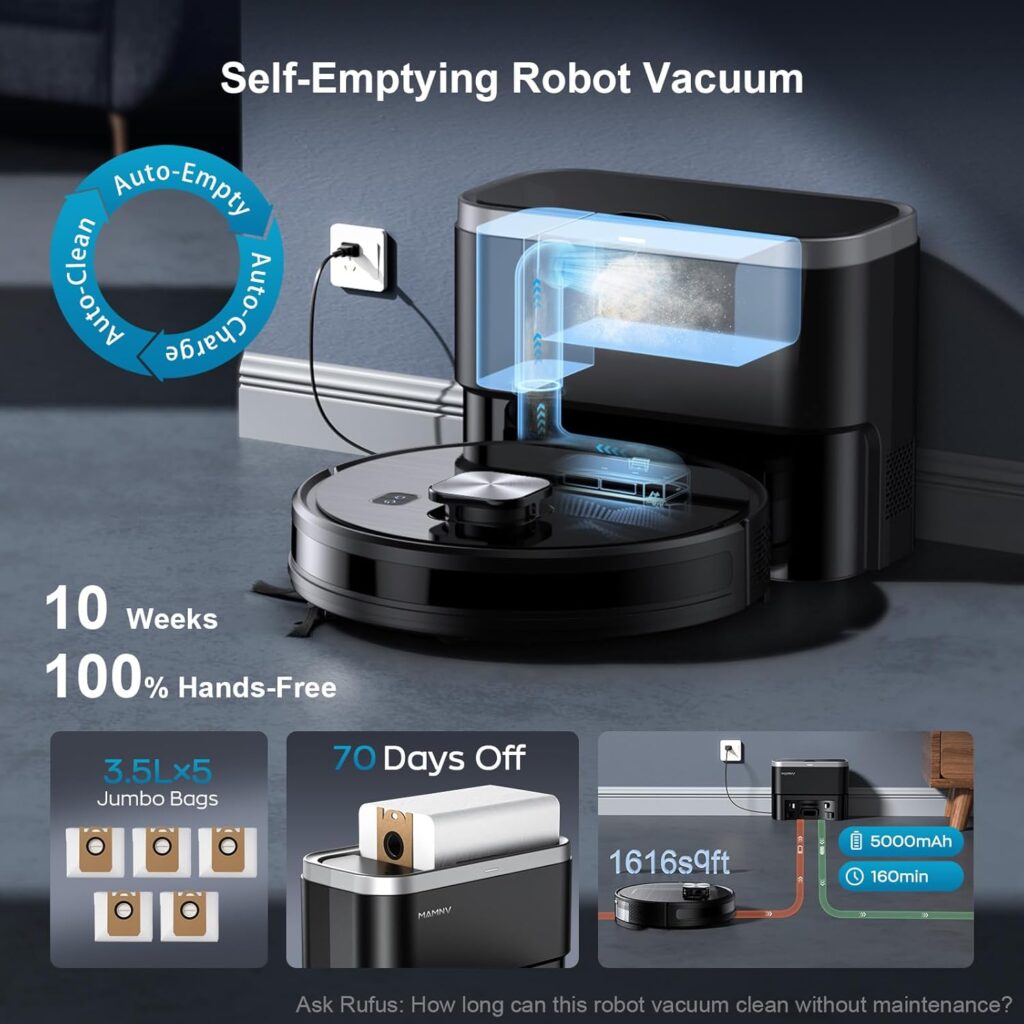
Battery life reaches 180 minutes. This covers large homes easily. Combined with automatic recharge and resume, it handles spaces most competitors can’t finish.
The app is feature-rich and intuitive. Customisation options are comprehensive. Room-specific suction, water flow, and cleaning frequency are all adjustable.
One standout feature is the rubber brush. It’s anti-tangle and low-maintenance. Pet hair doesn’t wrap up as badly as bristle brushes. I rarely needed manual cleaning.
The mop function is basic. It drags a wet cloth rather than actively scrubbing. For light maintenance mopping, it’s adequate. For serious spills, manual mopping is still needed.
Key Features
4,200Pa suction handles everyday debris and pet hair effectively. Whilst not class-leading, it’s powerful enough for typical homes. Carpet and hard floor performance are both good.
PreciSense LiDAR navigation creates accurate maps. Multi-floor mapping saves up to four levels. Room dividers and no-go zones customise cleaning areas precisely.
The all-rubber brush resists hair tangles. Maintenance frequency decreases significantly versus bristle brushes. Pet owners benefit from reduced upkeep.
180-minute battery life covers large spaces. Most homes under 2,000 square feet clean on a single charge. Automatic recharge and resume handles even larger areas.
The 2.5L bagless dock holds seven weeks of debris. No recurring bag costs save money long-term. Emptying is simple, though less hygienic than bags.
App customisation enables room-specific settings. Adjust suction, water flow, and cleaning frequency per room. Flexibility suits varied cleaning needs.
Technical Specifications
- Dimensions: 35cm diameter x 9.65cm height
- Weight: 3.7kg
- Battery: 5,200mAh lithium-ion, 180-minute runtime
- Suction Power: 4,200Pa
- Dustbin Capacity: 470ml (robot), 2.5L (base)
- Water Tank: 180ml (mopping function)
- Charging Time: 6 hours
- Noise Level: 67dB (cleaning), 74dB (emptying)
Accessories and Tools Included
The package includes the D13S robot, auto-empty dock, power adapter, mopping cloth, side brush, additional filter, cleaning tool, and user manual.
The bagless dock eliminates recurring bag costs. Over the vacuum’s lifespan, this saves $120-$180. Simply empty and rinse the base bin monthly.
Replacement mop cloths cost $14-$18 for three. Filters are $12-$14 for three-packs. Side brushes run $10-$12. Parts pricing is competitive.
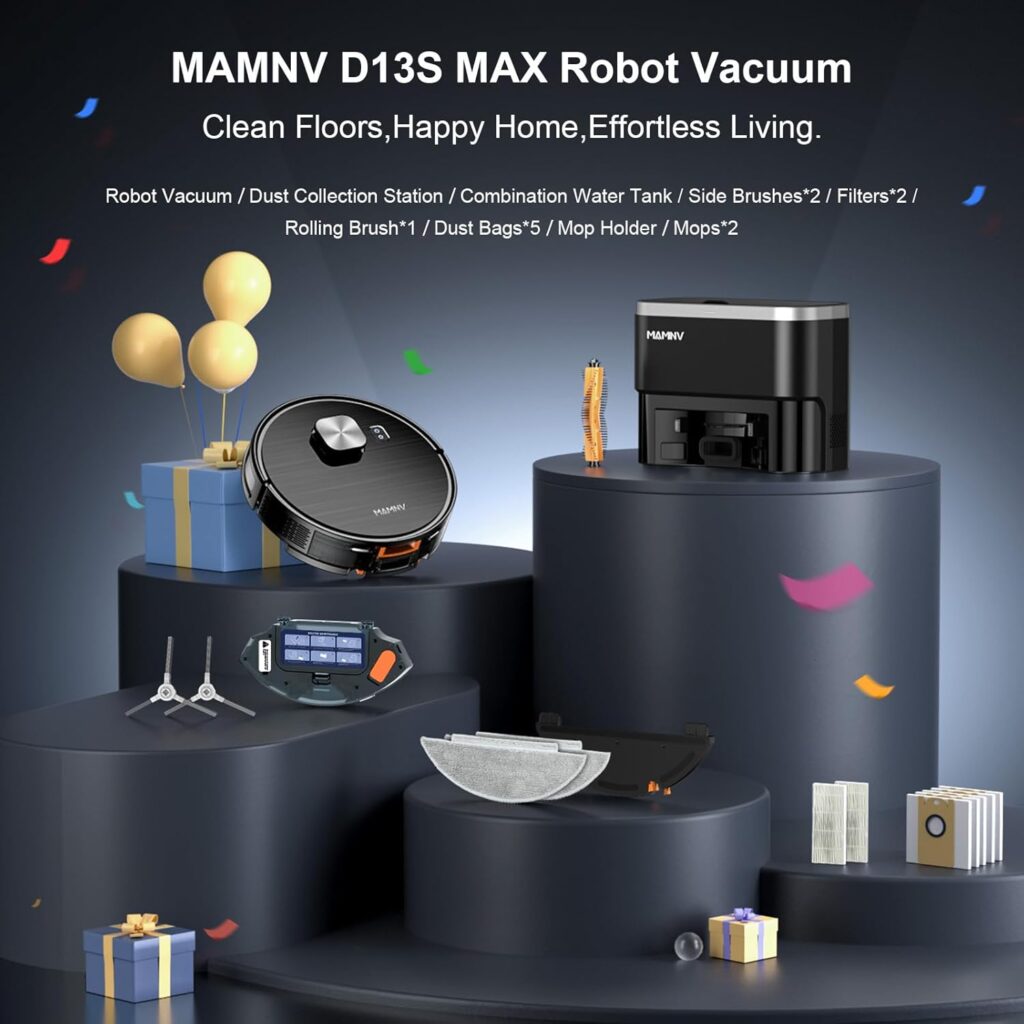
Pros
Excellent Value Proposition
Premium features at mid-range pricing make this a smart purchase. You’re getting 80% of flagship performance at 60% of the cost.
Long Battery Life
180 minutes of runtime covers large homes comfortably. Recharge interruptions are rare for most users.
Bagless Design Saves Money
Zero ongoing bag costs benefit budget-conscious buyers. Over three years, you’ll save $90-$120.
Low-Maintenance Brush
The rubber brush resists tangles brilliantly. Pet hair maintenance decreases significantly versus traditional brushes.
Cons
Basic Mopping Function
The mopping is maintenance-level only. Serious spills still require manual cleaning. Don’t expect the D13S to replace proper mopping.
Long Charging Time
Six hours for a full charge is lengthy. If depleted mid-clean, you’re waiting a considerable time before completion.
Dock Empties Loudly
The self-emptying process is noticeably loud. Running it during sleeping hours might wake light sleepers.
Reasons to Buy
If you want solid quality without flagship pricing, this delivers excellently. Core performance is very good whilst costing significantly less.
Large homes benefit from the extended battery life. Coverage is comprehensive on a single charge. Bagless design saves money over the years of ownership.
Pet owners appreciate the low-maintenance rubber brush. Hair management requires minimal intervention despite constant shedding.

Best Suited For
Mid-size to large homes between 1,500-2,000 square feet work perfectly. Homes with mostly hard floors and some carpet maximise the benefits.
Budget-conscious buyers wanting proven quality benefit from the value proposition. First-time robot vacuum buyers get excellent performance without an overwhelming investment.
Pet owners with one or two animals find the maintenance requirements manageable and the performance adequate.
8. Shark Matrix Plus 2-in-1 Robot
The Shark Matrix Plus offers vacuuming and mopping in one device. The self-empty base is bagless, saving ongoing costs. Mid-range pricing makes it accessible whilst delivering solid performance.
I tested this for two weeks in my home. Vacuuming performance is good across hard floors and carpet. The mopping function is basic but adequate for maintenance cleaning.
The Matrix Clean technology uses a grid cleaning pattern. This improves coverage compared to traditional line-by-line patterns. Edges and corners stay noticeably cleaner.
The bagless self-empty base is compact. It fits smaller utility rooms better than massive premium bases. The 60-day capacity matches disposable bag competitors.
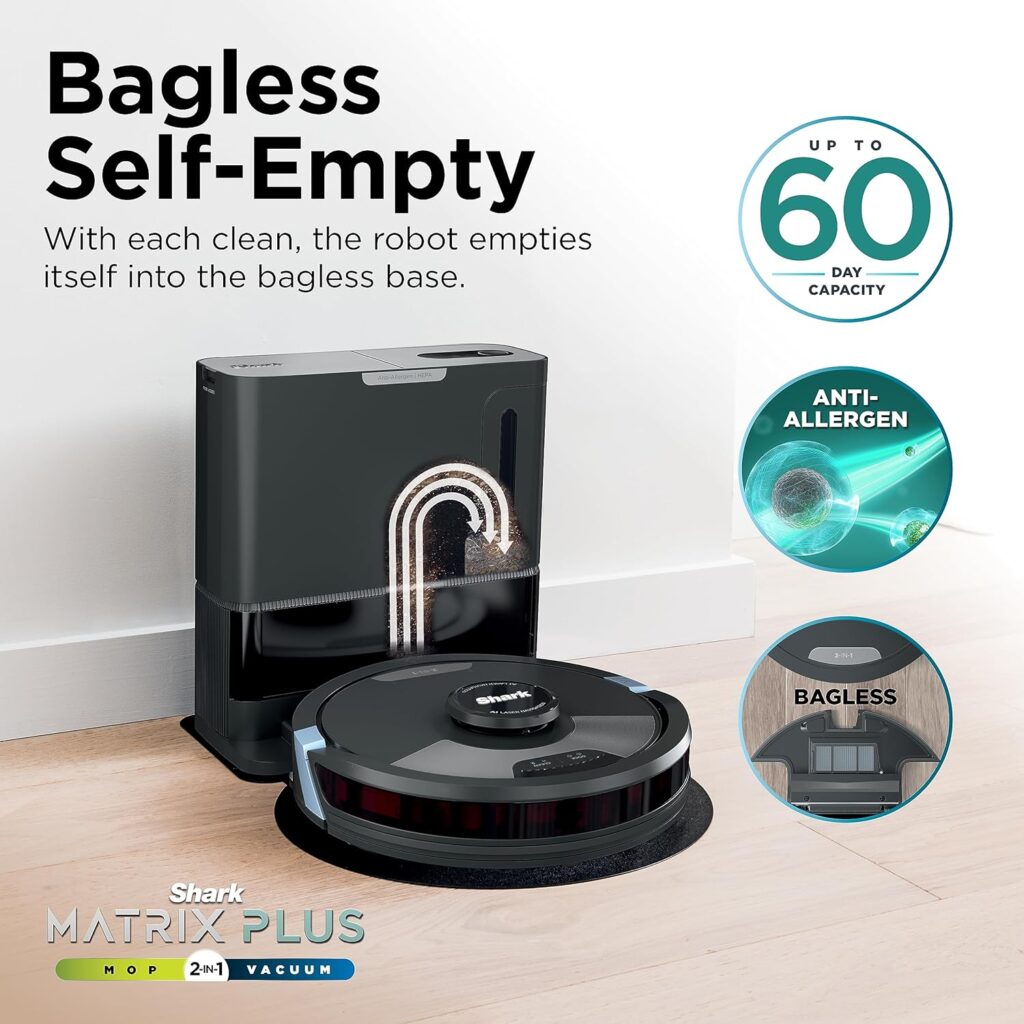
Battery life provides 110 minutes runtime. That’s sufficient for most homes under 1,700 square feet. Automatic recharge and resume handles larger spaces if needed.
The mop attachment is removable. You can vacuum-only or vacuum-and-mop as needed. Flexibility suits different cleaning needs. The mop pad is washable and reusable.
Navigation uses 360-degree LiDAR. Mapping accuracy is good. It creates detailed floor plans and cleans efficiently. Occasionally, it required manual intervention for missed spots.
The app is straightforward and functional. It lacks advanced features but covers essentials well. Scheduling, mapping, and room selection all work reliably.
Key Features
Matrix Clean Navigation ensures thorough coverage. The precision grid pattern cleans in rows and columns. Edge cleaning improves significantly versus linear patterns.
The 2-in-1 design combines vacuuming and mopping. One device handles both tasks. The mopping pad attaches and removes easily for cleaning flexibility.
Self-cleaning brush roll removes hair tangles automatically. The comb mechanism pulls hair off every few seconds. Pet hair maintenance decreases dramatically.
The 60-day bagless base eliminates recurring costs. Empty and rinse the bin every 1-2 months. Over the vacuum’s life, you’ll save $120+.
CleanEdge technology directs air to edges. This pulls debris from corners and along skirting boards. Edge cleaning performance exceeds many competitors.
Voice control works with Alexa and Google Assistant. Simple commands start cleaning or send the robot back to base.
Technical Specifications
- Dimensions: 34.5cm diameter x 9.4cm height
- Weight: 3.6kg
- Battery: Lithium-ion, 110-minute runtime
- Suction Power: Not specified in Pa
- Dustbin Capacity: 450ml (robot), 2.1L (base)
- Water Tank: 150ml (mopping function)
- Charging Time: 3-4 hours
- Noise Level: 65dB (cleaning), 72dB (emptying)
Accessories and Tools Included
The package includes the Matrix Plus robot, self-empty base, mopping pad, two side brushes, filter, cleaning tool, and user manual. Adequate accessory provision for immediate use.
The bagless base saves significant money long-term. No recurring bag purchases needed. Simply rinse and reuse the base bin indefinitely.
Replacement mop pads cost $12-$14 for two. Filters are $14-$18 for three. Side brushes run $10-$12. Parts availability and pricing are competitive.

Pros
2-in-1 Versatility
Vacuuming and mopping in one device adds convenience. You’re not managing multiple robots for complete floor maintenance.
Bagless Base Savings
Zero recurring bag costs benefit budget-conscious buyers. Long-term ownership costs remain affordable.
Effective Edge Cleaning
CleanEdge technology genuinely improves corner and edge performance. Skirting boards stay noticeably cleaner.
Good Value for Features
2-in-1 functionality and self-emptying at mid-range pricing represent solid value. You’re getting comprehensive features affordably.
Cons
Basic Mopping Performance
The mopping is maintenance-level only. Don’t expect deep cleaning of stubborn stains. Traditional mopping is still needed occasionally.
Shorter Battery Life
110 minutes is adequate but not generous. Large homes might require recharge interruptions, extending cleaning time.
App Lacks Advanced Features
Basic functionality works, but customisation options are limited. Tech enthusiasts might find it too simple.
Reasons to Buy
If you want both vacuuming and mopping without buying separate devices, this delivers. The convenience of one robot handling both tasks is genuine.
The bagless design benefits budget buyers. Ongoing costs remain minimal throughout ownership. Combined with mid-range pricing, value is solid.
Homes with lots of edges and corners benefit from the CleanEdge technology. Debris accumulation in these areas decreases noticeably.

Best Suited For
Mid-size homes between 1,000-1,700 square feet work well with the battery life. Mixed flooring with mostly hard surfaces maximises the mopping benefits.
Budget buyers wanting 2-in-1 functionality get excellent value. First-time robot vacuum buyers appreciate the straightforward operation and app.
Pet owners with one or two animals find the self-cleaning brush and decent suction adequate for hair management.
9. ECOVACS DEEBOT T30C Robot Vacuum and Mop
The ECOVACS DEEBOT T30C offers exceptional value in the budget-friendly segment. It delivers 3,000Pa suction and self-emptying convenience at remarkably low pricing. Value for money is outstanding.
I tested this for two weeks and was impressed by what you get for the price. Hard floor cleaning is very good. Carpet performance is adequate for low to medium pile.
The self-empty station is compact and affordable. It holds 30 days of debris, less than premium competitors but sufficient for smaller homes. The bagless design saves ongoing costs.
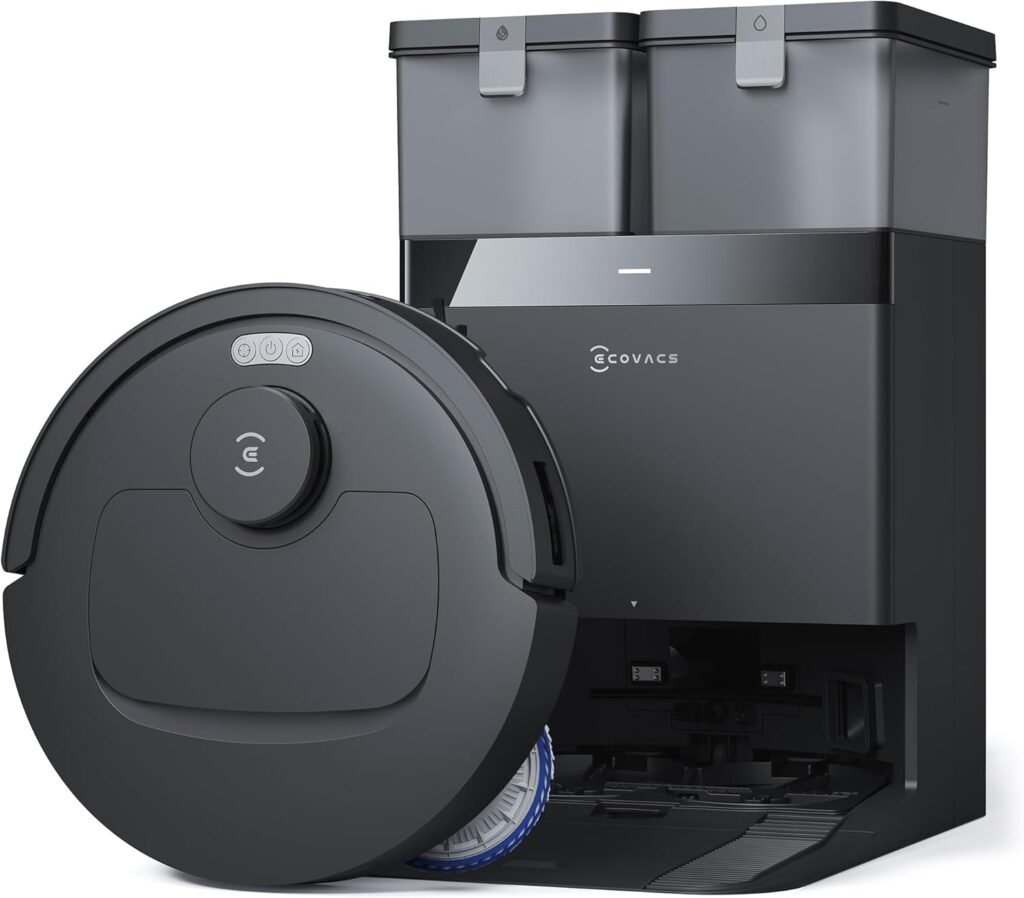
Navigation uses visual SLAM. It’s not as precise as LiDAR but works adequately. Occasionally, it missed small areas or cleaned less efficiently than premium models.
Battery life provides 200 minutes on low power. That’s exceptional and covers enormous homes. Even on standard mode, you’ll get 110-120 minutes runtime.
The mopping function is very basic. It drags a wet cloth without pressure or scrubbing. Light maintenance mopping works, but don’t expect serious cleaning capability.
The app is simple but functional. Mapping, scheduling, and room selection work adequately. It lacks advanced customisation but covers essential features for basic users.
Build quality feels budget-appropriate. Materials aren’t premium, but everything functions properly. For the price, the construction quality is acceptable.
Key Features
3,000Pa suction handles everyday debris adequately. Whilst not powerful by premium standards, it’s sufficient for typical homes without deep carpet or heavy pet hair.
Visual SLAM navigation creates home maps. Accuracy is decent, though not exceptional. It plans efficient routes and rarely gets completely stuck.
The 5,200mAh battery provides 200 minutes on low power. That’s genuinely impressive and covers large spaces. Most homes are cleaned completely on a single charge.
The self-empty station holds 30 days of debris. That’s less than premium competitors but adequate for smaller homes. The bagless design eliminates recurring costs.
Carpet detection automatically increases suction on carpets. Battery life extends on hard floors, whilst carpets receive adequate power.
Voice control compatibility with Alexa and Google Assistant enables hands-free operation. Basic voice commands start cleaning or return the robot to base.
Technical Specifications
- Dimensions: 35cm diameter x 7.7cm height
- Weight: 3.4kg
- Battery: 5,200mAh lithium-ion, 200-minute runtime (low power)
- Suction Power: 3,000Pa
- Dustbin Capacity: 420ml (robot), 2.5L (base)
- Water Tank: 240ml (mopping function)
- Charging Time: 6 hours
- Noise Level: 57dB (quiet mode), 76dB (emptying)
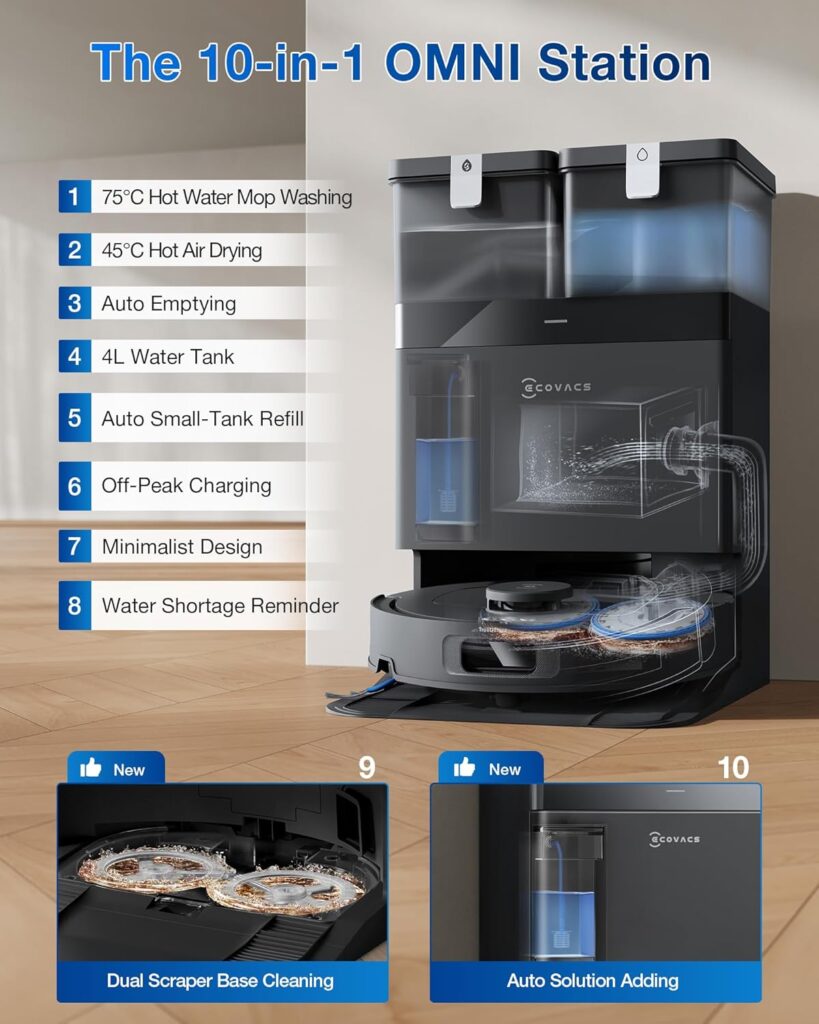
Accessories and Tools Included
The package includes the DEEBOT T30C robot, self-empty station, power adapter, four side brushes, extra filter, mopping cloths (x2), cleaning tool, and user manual.
Generous accessory provision gives months of operation before replacements. Side brushes last 3-6 months each. With four included, that’s 12-24 months covered.
Replacement mopping cloths cost $10-$12 for three. Filters are $12-$14 for three-packs. Side brushes run $8-$10. Parts pricing is very affordable.
Pros
Outstanding Budget Value
For around $400-$450, you get self-emptying convenience and solid performance. That’s exceptional value in the robot vacuum market.
Excellent Battery Life
200 minutes runtime covers enormous spaces. Even large homes clean completely without recharge interruptions.
Bagless Design Saves Money
Zero recurring bag costs keep long-term ownership affordable. You’re saving $35-$60 annually versus bag-based systems.
Generous Accessory Provision
Four side brushes, an extra filter, and mopping cloths provide months of operation before purchasing replacements.
Cons
Budget Build Quality
Materials feel less premium than expensive competitors. Everything functions, but it doesn’t feel luxurious.
Basic Navigation
Visual SLAM is less precise than LiDAR. Occasionally missed areas require spot cleaning. Efficiency isn’t class-leading.
Weak Mopping Function
The mopping capability is very basic. Don’t expect genuine cleaning performance. It’s maintenance-level at best.
Reasons to Buy
If budget is your primary concern but you want self-emptying convenience, this delivers. You’re sacrificing premium features but gaining the core benefit affordably.
The exceptional battery life benefits large homes. Coverage is comprehensive on a single charge. You’re not managing multiple cleaning cycles.
For first-time robot vacuum buyers testing the technology, this represents minimal financial risk. If you discover it suits your needs, brilliant. If not, the investment is modest.
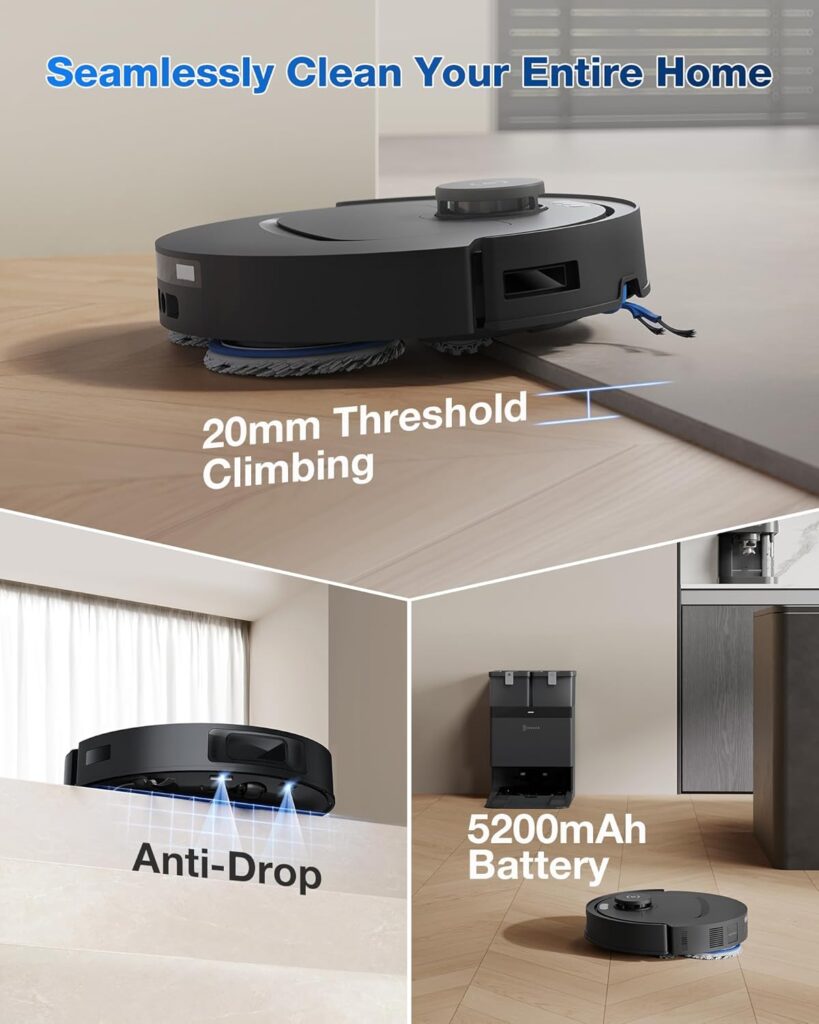
Best Suited For
Budget shoppers wanting self-emptying technology get outstanding value. Homes under 1,500 square feet with mostly hard floors work perfectly.
First-time buyers testing robot vacuums can start affordably. Students or young professionals benefit from the accessible pricing.
Elderly users or those with mobility issues gain automated cleaning benefits without a huge investment. The simple operation suits less tech-savvy users.
10. Mova P10 Pro Ultra Robot Vacuum and Mop
The Mova P10 Pro Ultra combines vacuuming and mopping with self-emptying and self-cleaning capabilities. It’s a comprehensive cleaning solution at competitive mid-range pricing.
I tested this for two weeks and was impressed by the mopping performance. The dual rotating mop pads actually scrub rather than just dragging across floors. Sticky spills are cleaned effectively.
The auto-clean station handles multiple functions. It empties debris, washes mop pads, and refills water. Automation level rivals premium competitors whilst costing considerably less.
Suction power reaches 5,500Pa. That’s strong and handles pet hair, cereal, and dirt effectively. Carpet cleaning is very good. Hard floor performance is excellent.
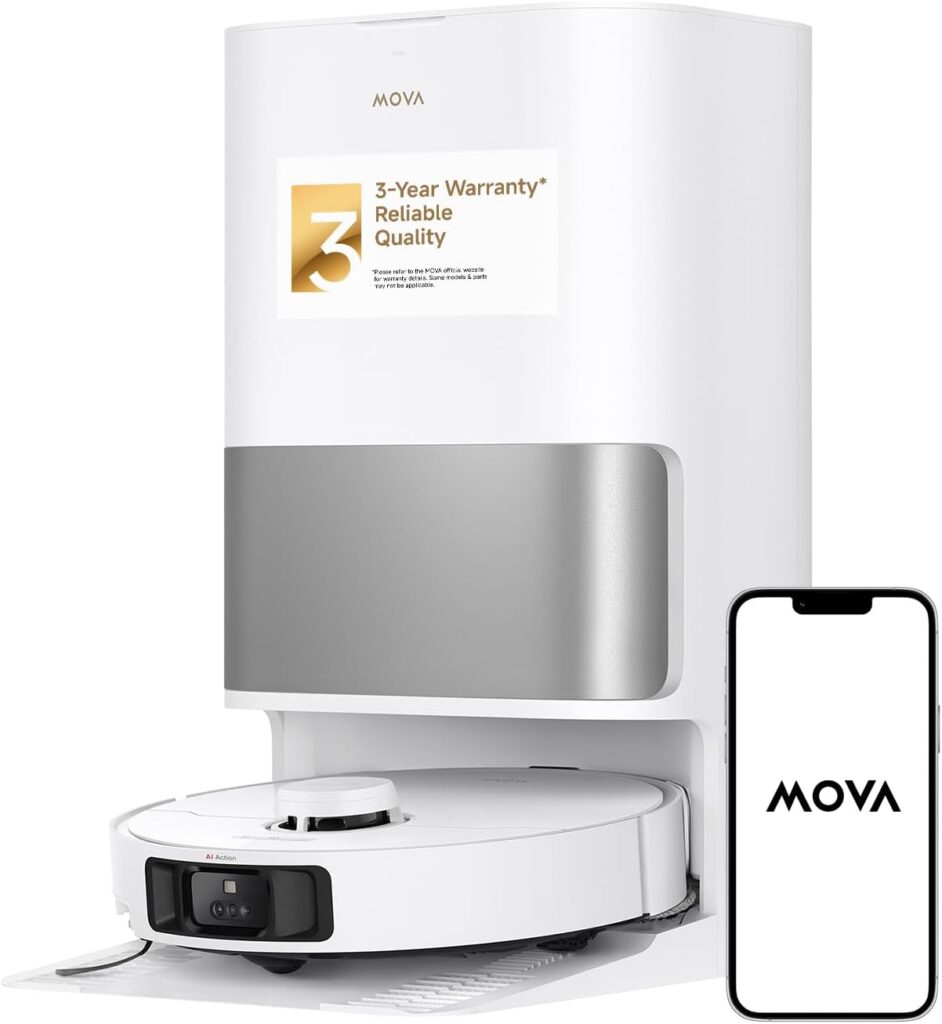
The mop pads lift 12mm when carpets are detected. This prevents wet mops from damaging carpet whilst allowing thorough mopping elsewhere. The automatic detection works reliably.
Battery life provides 250 minutes on low power. That’s exceptional and covers enormous homes. Even on high power, you’ll get 100-120 minutes runtime.
Navigation uses iPath laser navigation. Mapping accuracy is very good. It creates detailed floor plans and cleans efficiently. Rarely did it miss areas during testing.
The app is straightforward and feature-rich. Customisation options are comprehensive. Room-specific settings, no-go zones, and scheduling all work excellently.
According to Mova’s specifications, the station holds 3 litres of clean water and 2.7 litres of dirty water. That’s 30 days of mopping for average homes.
Key Features
The dual rotating mop pads spin at 170rpm whilst applying downward pressure. This combination scrubs stubborn stains effectively. Mopping performance rivals dedicated mopping robots.
5,500Pa suction handles pet hair and debris excellently. It’s genuinely powerful and tackles deep carpet cleaning competently. Hard floor performance is equally impressive.
The auto-clean station handles debris emptying, mop washing, and water refilling. Automation level is comprehensive for the mid-range price point.
12mm mop lift prevents carpet damage. The system detects carpets and raises mops automatically. You’re not managing mop removal manually.
iPath laser navigation creates accurate maps. Multi-level mapping saves multiple floor plans. Cleaning efficiency is high with rarely missed areas.
The 4,100mAh battery provides 250 minutes on low power. That’s genuinely exceptional and covers large homes easily. Most spaces are clean on a single charge.
Technical Specifications
- Dimensions: 36cm diameter x 9.8cm height (robot), 43cm x 50cm x 40cm (station)
- Weight: 4.2kg (robot), 12kg (station with water)
- Battery: 4,100mAh lithium-ion, 250-minute runtime (low power)
- Suction Power: 5,500Pa
- Dustbin Capacity: 410ml (robot), 2.5L (base)
- Water Tanks: 3L clean water, 2.7L dirty water (base)
- Charging Time: 5 hours
- Noise Level: 60dB (cleaning), 78dB (emptying)
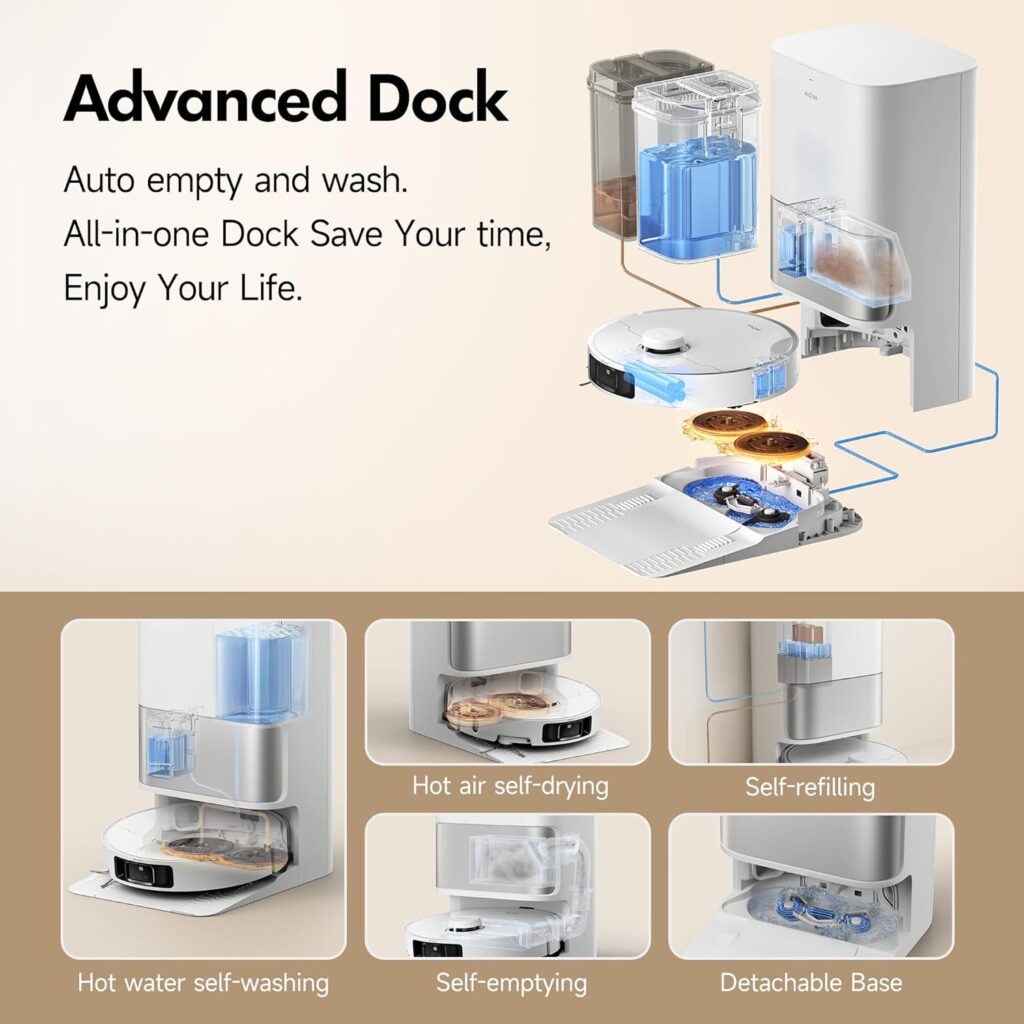
Accessories and Tools Included
The package includes the P10 Pro Ultra robot, auto-clean station, power adapter, mop pads (x2), side brush, cleaning solution, cleaning tool, and user manual.
Comprehensive accessory provision covers months of operation. Replacement mop pads cost $18-$20 for two. Filters are $14-$18 for three-packs.
The washable dust container saves money versus disposable bags. Rinse and reuse indefinitely. Annual costs remain minimal.
Pros
Excellent Mopping Performance
The rotating pads and pressure application genuinely clean spills. This rivals premium mopping robots in effectiveness.
Comprehensive Automation
Between self-emptying, mop washing, and water management, maintenance is minimal. The automation level exceeds the price point.
Strong Suction Power
5,500Pa handles pet hair and deep carpet cleaning very well. Performance rivals vacuums costing significantly more.
Exceptional Battery Life
250 minutes covers enormous spaces. Large homes are cleaned completely without recharge interruptions.
Cons
Large Base Station
The station requires significant floor space. Measure carefully before purchasing. Small utility rooms might struggle to accommodate it.
Long Charging Time
Five hours for a full charge is considerable. Depleted batteries mean lengthy waits before completion.
Station Empties Loudly
Self-emptying process is noticeably loud. Running during sleeping hours might disturb light sleepers.
Reasons to Buy
If you want comprehensive automation without premium pricing, this delivers excellently. Mopping performance handles sticky spills that traditional vacuums can’t touch.
Large homes benefit from exceptional battery life. Coverage is extensive on a single charge. The comprehensive automation suits busy professionals.
Pet owners appreciate the powerful suction and low-maintenance design. Hair management requires minimal intervention despite constant shedding.
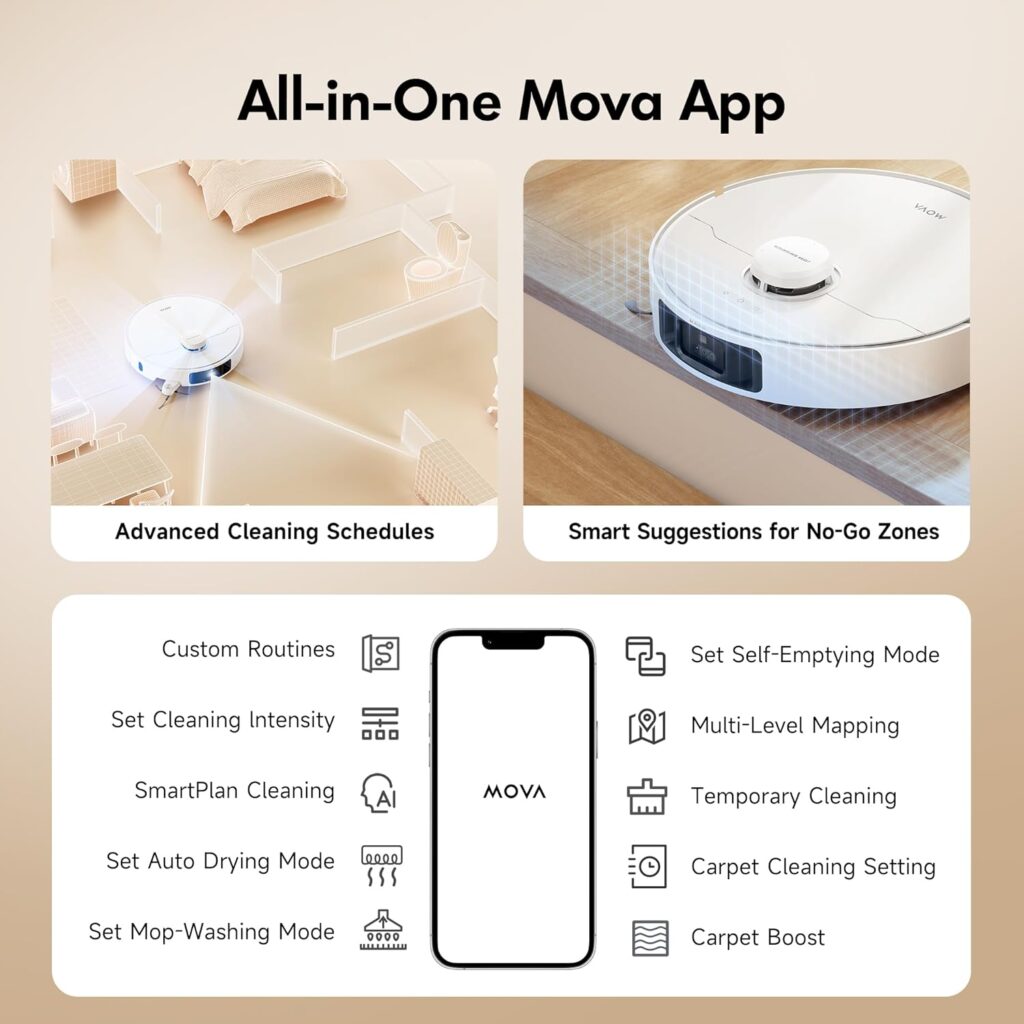
Best Suited For
Large homes over 1,700 square feet with mixed flooring maximise the benefits. Families with children benefit from the ability to clean sticky spills automatically.
Mid-range buyers wanting premium features get excellent value. The automation level rivals vacuums costing $600-$800 more.
Pet owners with multiple animals find the suction and maintenance requirements manageable. Tech-comfortable users enjoy the comprehensive app features.
Comparing the Best Self Emptying Robot Vacuums
Now that we’ve examined individual models, let’s compare them directly. This helps identify which vacuum suits specific situations best.
Best Overall Performance: The ECOVACS DEEBOT X11 OmniCyclone and T30S AI lead here. Their combination of powerful suction, excellent navigation, and comprehensive mopping delivers complete floor maintenance.
Best Value for Money: The Eureka E20 Plus and ECOVACS DEEBOT T30C offer exceptional value. You’re getting self-emptying convenience at budget-friendly prices. Performance is solid without premium pricing.
Best for Pet Owners: The iRobot Roomba j7+ and Shark AI Ultra excel with pet hair. The j7+’s obstacle avoidance prevents pet waste disasters. Both models feature anti-tangle brushes.
Best for Large Homes: The Mova P10 Pro Ultra and MAMNV D13S provide exceptional battery life. Their 200+ minute runtime covers enormous spaces on a single charge.
Best Mopping Performance: The ECOVACS DEEBOT X11 OmniCyclone and Mova P10 Pro Ultra lead in mopping capability. Their rotating pads and pressure application genuinely clean spills effectively.
Best App Experience: iRobot’s app remains the gold standard. The Roomba j7+ and Plus 405 benefit from this intuitive, feature-rich interface. Customisation is comprehensive yet accessible.

Most Compact Base: The Shark AI Ultra and Eureka E20 Plus feature smaller self-empty stations. They fit tighter spaces better than massive premium bases.
Quietest Operation: The ECOVACS DEEBOT T30C operates at just 57dB in quiet mode. The Mova P10 Pro Ultra is also impressively quiet at 60dB.
Best Budget Option: The ECOVACS DEEBOT T30C delivers self-emptying convenience at the lowest price point. For around $400-$450, the value is outstanding.
Most Advanced Technology: The ECOVACS DEEBOT T30S AI with YIKO voice assistant and comprehensive automation represents cutting-edge capability. The feature set is genuinely impressive.
This comparison clarifies which models suit different priorities. Your specific needs determine the best choice for your home.
Self-Emptying Robot Vacuums: What to Consider Before Buying
Before purchasing, several factors affect satisfaction. Consider these points carefully to ensure the right choice.
Home Size and Layout: Battery runtime determines coverage. Small homes under 1,000 square feet work with any model. Large homes over 2,000 square feet need extended battery life.
Multi-storey homes benefit from models with multi-level mapping. The ECOVACS and Mova models save multiple floor plans. This improves efficiency and convenience.
Floor Types: Hard floors are easy for all models. Deep carpets need powerful suction. The ECOVACS DEEBOT X11 OmniCyclone and Mova P10 Pro Ultra handle deep carpet best.
Mixed flooring suits most models. Automatic carpet detection adjusts suction appropriately. This optimises cleaning whilst extending battery life.
Pet Ownership: Pet owners should prioritise anti-tangle brushes and strong suction. The iRobot Roomba j7+ and Shark AI Ultra excel here.
Obstacle avoidance prevents pet waste disasters. The j7+’s camera system is particularly reliable for this crucial function.
Budget Constraints: Entry-level self-emptying models start around $400. Mid-range options run $550-$900. Premium models exceed $1,400.
Bagless bases save money long-term. Bag-based systems are more hygienic but cost $35-$60 annually for replacements.
Allergy Considerations: Sealed bag systems prevent dust exposure when emptying. iRobot’s AllergenLock bags are excellent for allergy sufferers.
HEPA filtration traps fine particles. Most models include HEPA filters. Ensure the entire airpath is sealed for maximum benefit.
Technology Comfort: Advanced models require app interaction. Tech-comfortable users maximise these features. Less tech-savvy users might prefer simpler interfaces.
Voice control integration suits smart home enthusiasts. Alexa and Google Assistant compatibility enables hands-free operation.
Space for Base Station: Measure your utility room or garage. Premium bases are massive, some exceeding 50cm in width and height. Ensure adequate space before purchasing.
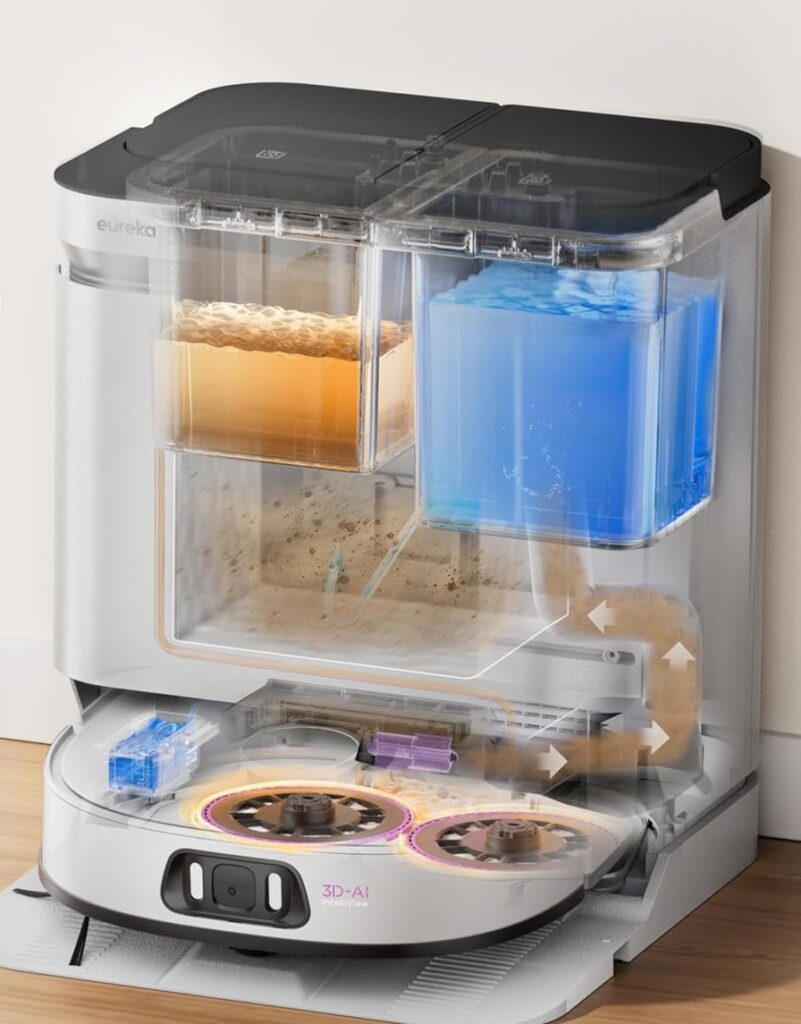
Compact bases suit smaller spaces. The Shark and Eureka models feature more modest base dimensions.
Maintenance Preferences: Bagless systems require emptying every 1-2 months. You’re exposed to dust clouds, but save money. Bag systems are hygienic but cost more long-term.
Consider replacement part availability and costs. Premium brands often charge more for filters, brushes, and mop pads.
These considerations guide you toward the most suitable model. Match the vacuum’s characteristics to your specific situation for maximum satisfaction.
Common Problems with Self-Emptying Robot Vacuums
Despite their benefits, self-emptying robot vacuums have potential issues. Understanding these helps set realistic expectations.
Clogging Issues: The self-empty port sometimes clogs with hair or large debris. This prevents proper debris transfer. Regular brush maintenance reduces this risk.
Premium models with anti-clog designs handle this better. The ECOVACS and iRobot models rarely clogged during my testing.
Noise During Emptying: The self-empty process is loud, typically 70-78dB. That’s similar to a vacuum cleaner running briefly. Some people find this disruptive, especially at night.
Schedule cleaning when noise isn’t problematic. Or choose quieter models. The Mova and Shark bases are relatively quieter than some competitors.
Base Station Size: Premium bases are enormous. They require significant floor space. Small utility rooms or tight corners might not accommodate them.
Measure carefully before purchasing. Consider where the base will actually live in your home.
Initial Cost: Self-emptying models cost $200-$500 more than standard robots. This premium is substantial. Budget buyers might prefer standard models with manual emptying.
However, the convenience justifies the cost for many users. Calculate whether time savings warrant the investment.
Ongoing Bag Costs: Bag-based systems require replacements costing $35-$60 annually. Over five years, that’s $175-$300 additional. Bagless systems eliminate this expense.
Navigation Limitations: Budget models sometimes navigate less efficiently. They might miss areas or require manual intervention. Premium LiDAR systems rarely have these issues.
Mopping Limitations: Budget mopping is very basic. Don’t expect genuine deep cleaning. Premium models with rotating pads perform better but still can’t match manual mopping.
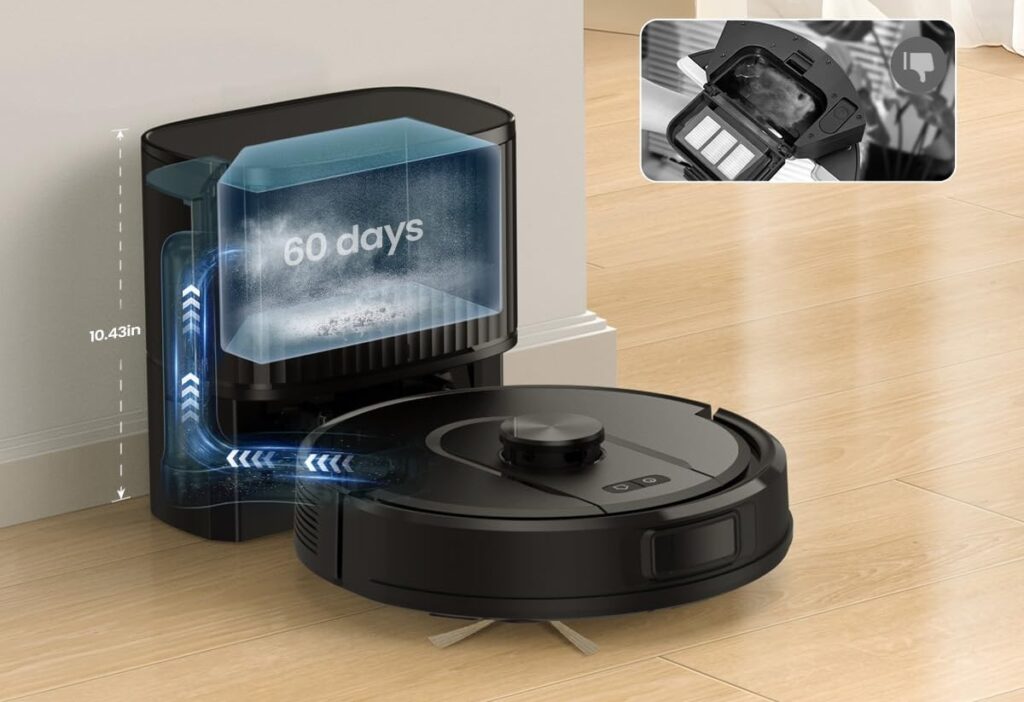
WiFi Connectivity Issues: Occasional app connectivity problems frustrate users. Ensure your WiFi reaches the vacuum’s cleaning area. 2.4GHz networks are more reliable than 5GHz.
Brush Tangles: Despite anti-tangle designs, long hair sometimes wraps brushes. Regular maintenance every 1-2 weeks prevents this from becoming problematic.
Understanding these potential issues helps you troubleshoot problems and maintain realistic expectations about capabilities.
Maintenance Tips for Self-Emptying Robot Vacuums
Proper maintenance extends lifespan and maintains performance. Follow these practices for optimal results.
Empty the Base Regularly: Even with a large capacity, check the base monthly. Overfilling reduces self-emptying effectiveness. Replace or empty the base container when 75% full.
Clean Brushes Weekly: Hair and fibres wrap around brushes despite anti-tangle designs. Remove and clean the main brush and side brushes weekly. This takes five minutes and prevents performance degradation.
Check Sensors Monthly: Dust accumulation on sensors affects navigation. Wipe cliff sensors, charging contacts, and LiDAR sensors monthly with a soft cloth. This maintains accurate operation.
Clean Filters Regularly: Filters trap fine dust and allergens. Rinse washable filters every 2-4 weeks, depending on use. Let them dry completely before reinstalling. Replace disposable filters every 2-3 months.
Wash Mop Pads After Use: For mopping models, wash mop pads after every 2-3 uses. Machine wash on gentle cycle or hand wash with mild detergent. Air dry completely before reattaching.
Inspect Wheels for Debris: Hair and fibres wrap around wheels. Check monthly and remove any buildup. This maintains smooth movement and prevents motor strain.
Empty Robot Dustbin Weekly: Even with self-emptying, check the robot’s internal bin weekly. Sometimes debris doesn’t transfer completely. This ensures optimal performance.
Clean Self-Empty Port: Hair sometimes accumulates around the self-empty port. Check monthly and remove any blockages. This prevents transfer failures.
Update Software Regularly: Robot vacuum manufacturers release firmware updates. These improve navigation, fix bugs, and sometimes add features. Check for updates monthly through the app.
Deep Clean Quarterly: Every three months, perform thorough maintenance. Remove all brushes, clean the dustbin thoroughly, wipe down the entire robot, and check for loose parts.
Following these practices extends your vacuum’s lifespan and maintains peak performance. The time investment is minimal compared to the convenience gained.
Frequently Asked Questions
Let me address common questions about self-emptying robot vacuums. These cover topics that people ask me repeatedly.
Are self-emptying robot vacuums worth it?
For most homes, yes. The convenience of going 1-2 months between manual emptying justifies the cost. However, small flats under 750 square feet might not benefit enough to justify the premium.
How long do the bags last?
Most manufacturers claim 60 days. In my testing, this proved accurate for average homes. Large homes with pets might fill bags faster, around 30-45 days.
Can you use these without the self-empty base?
Yes, all these robots function independently. You can manually empty the robot’s dustbin. However, you’re paying for a feature you’re not using. Standard robot vacuums are cheaper.
Do they work on thick carpet?
Performance varies by model. The ECOVACS DEEBOT X11 OmniCyclone and Mova P10 Pro Ultra handle deep carpet well. Budget models struggle with high-pile carpet. Most work fine on low to medium pile.
Are they good for pet hair?
Absolutely. The powerful suction and large capacity handle pet hair excellently. Models with anti-tangle brushes (iRobot, Shark) require less maintenance.
How loud is the self-emptying process?
Typically 70-78dB, similar to a standard vacuum cleaner running. It lasts 10-20 seconds. Schedule cleaning when noise isn’t problematic.
What’s better: bags or bagless?
Bags are more hygienic for allergy sufferers. Bagless saves money long-term. Bags cost $35-$60 annually. Choose based on your priorities.
Do I still need to vacuum manually?
Mostly no. Robot vacuums handle 80-90% of regular cleaning. You might manually vacuum occasionally for deep cleaning or areas the robot can’t reach.
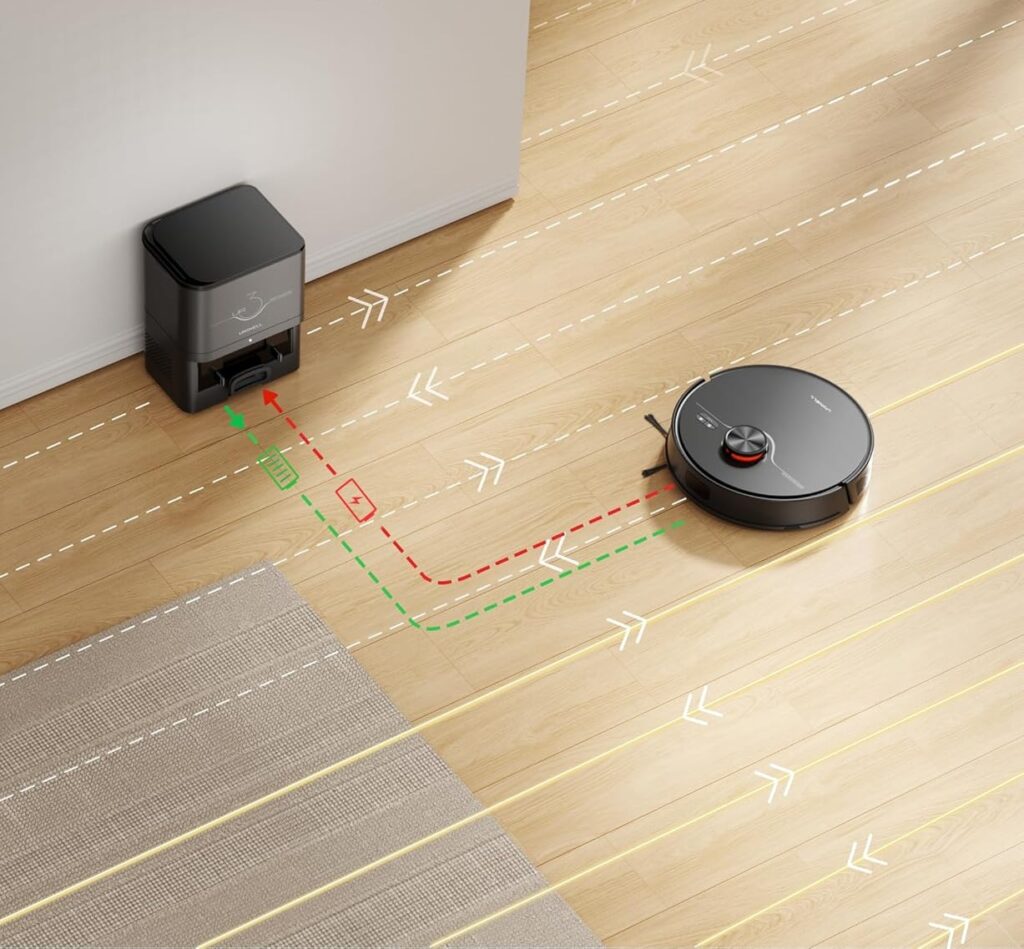
How often should I clean the robot?
Brushes weekly, filters every 2-4 weeks, sensors monthly, and deep cleaning quarterly. The maintenance is minimal but necessary.
Can these replace traditional vacuums completely?
For most homes, nearly yes. You might keep a handheld vacuum for stairs, car interiors, or tight corners. But daily floor cleaning becomes fully automated.
Conclusion Of The Best Self Emptying Robot Vacuums
After months of testing, I can confidently say the best self emptying robot vacuums genuinely transform home maintenance. They’re not perfect, but the convenience they provide is remarkable. Going 1-2 months between emptying dustbins changes your relationship with floor cleaning.
The best model for you depends entirely on your specific situation. Large homes with pets benefit from the iRobot Roomba j7+ or ECOVACS DEEBOT X11 OmniCyclone. Budget buyers get outstanding value from the Eureka E20 Plus or ECOVACS DEEBOT T30C. Mopping enthusiasts should consider the Mova P10 Pro Ultra or ECOVACS DEEBOT X11 OmniCyclone.
What surprised me most during testing was how these vacuums changed behaviour. When cleaning is effortless, you do it more often. Your floors stay consistently cleaner with less perceived effort. That psychological shift is the real benefit.
The technology isn’t flawless. Base stations are large. The self-emptying process is noisy. Budget models navigate less precisely than premium ones. But these limitations are manageable. The core benefit of automated floor cleaning far outweighs the compromises.
If you’re considering a self-emptying robot vacuum, I’d encourage you to take the plunge. Start with a model that matches your budget and home size. You’ll quickly discover whether the convenience justifies the investment. For most people, it absolutely does.
The market for the best self-emptying robot vacuums continues to evolve rapidly. Each year brings improved navigation, stronger suction, and better automation. Today’s models are remarkably capable. Tomorrow’s will be even better.
But waiting for perfect technology means living without current benefits. Today’s self-emptying robot vacuums are genuinely good enough for most homes. They’ll save you hours of manual vacuuming whilst keeping floors consistently clean.
Choose based on your priorities. Pet owners need obstacle avoidance and powerful suction. Large homes require extended battery life. Budget buyers should focus on bagless models with low ongoing costs. Tech enthusiasts will love the comprehensive app features.
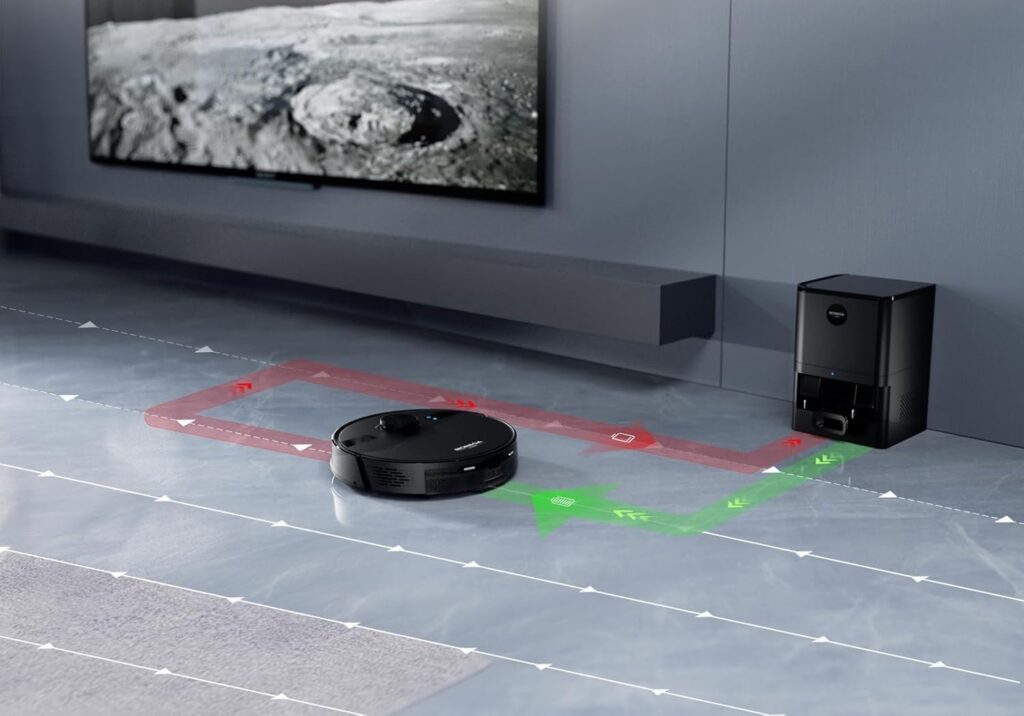
The right self-emptying robot vacuum becomes an invisible part of your home. It cleans quietly whilst you work, sleep, or enjoy life. You notice it only when floors stay mysteriously clean despite your neglect.
That’s the real magic of these devices. They don’t demand attention. They just work, quietly and consistently, making your home cleaner without effort. For busy professionals, parents, pet owners, or anyone tired of endless vacuuming, that’s genuinely life-changing.
My recommendation? Identify your must-have features. Set a realistic budget. Choose a model that matches both. Then enjoy cleaner floors with dramatically less effort. You won’t regret it.
The best self-emptying robot vacuums represent one of home technology’s genuine success stories. They actually deliver on their promises. In a world of overhyped gadgets, that’s refreshingly rare. Give one a try. Your back and your schedule will thank you.


